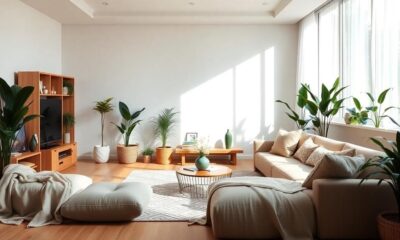Decor
The Secret to Balancing Modern Decor With Traditional Batik Patterns
Keen to discover how to harmoniously blend modern decor with vibrant batik patterns? Uncover the secrets that will transform your space beautifully.
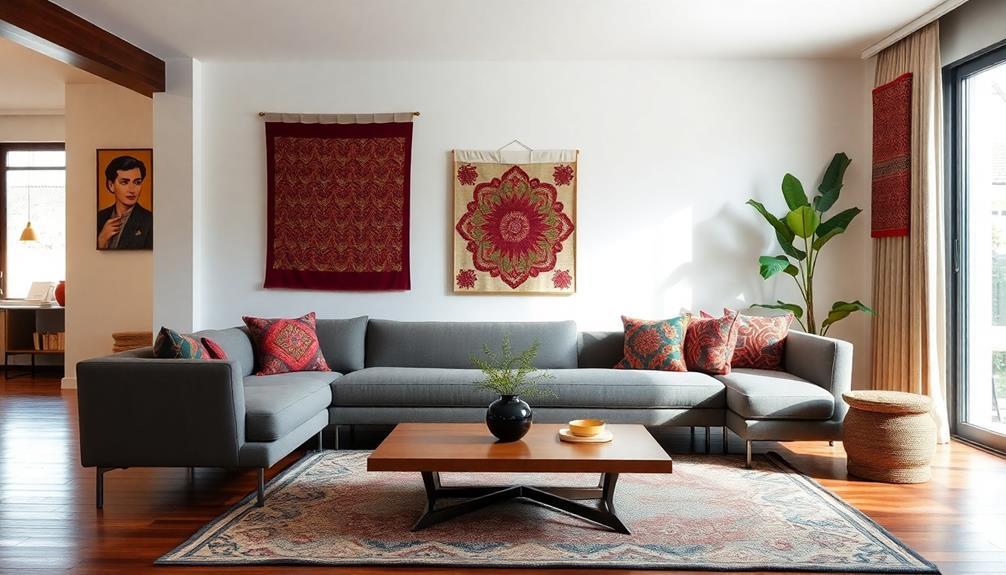
You can effortlessly balance modern decor with traditional batik patterns by focusing on color harmony and texture. Start by using neutral tones as a backdrop, allowing the vibrant batik colors to pop. Choose batik as accent pieces like throw pillows or table runners to introduce cultural richness without overwhelming your space. Combine batik textiles with sleek metals or natural woods for visual contrast. When selecting fabrics, prioritize durability and eco-friendly materials. By thoughtfully incorporating these elements, you'll create a stylish dialogue between the old and new. There's plenty more to explore on how to enhance your decor with these unique patterns.
Key Takeaways
- Combine batik's vibrant colors with neutral backgrounds to let the patterns stand out without overwhelming the space.
- Use batik as accent pieces, such as throw pillows or table runners, to introduce cultural richness subtly.
- Incorporate a limited color palette that mirrors dominant hues in batik for a cohesive design.
- Layer batik textiles with sleek metals or natural woods to create textural contrast and balance.
- Opt for eco-friendly batik fabrics made from natural materials to align modern decor with sustainable practices.
Understanding Batik's Cultural Roots

When you plunge into batik, you uncover a rich tapestry of cultural heritage that stretches back over 2000 years. Originating in Indonesia, particularly on the island of Java, batik's name comes from the Javanese word "ambatik," meaning cloth with little dots.
Initially, it served as a medium for spiritual expression, with its intricate designs carrying deep symbolic meanings that reflect cultural beliefs and values. The artistry of batik also shares similarities with other traditional crafts, like the Indonesian decor mask, that highlight the country's diverse cultural expressions.
Batik isn't just fabric; it's a crucial part of Indonesian life and tradition. From traditional ceremonies to everyday clothing, batik plays an essential role, showcasing vibrant colors and detailed patterns that celebrate Indonesia's rich history.
Designs like Parang and Kawung highlight the skill and artistry involved in this wax-resist dyeing technique, which produces elaborate visuals that captivate the eye.
In recent years, batik has evolved, inspiring contemporary designs while maintaining its roots. This balance between tradition and modernity allows you to appreciate batik's cultural significance while incorporating it into your decor.
UNESCO recognized batik as a Masterpiece of Oral and Intangible Heritage of Humanity in 2009, underscoring its importance and the need for preservation.
The Process of Batik Creation
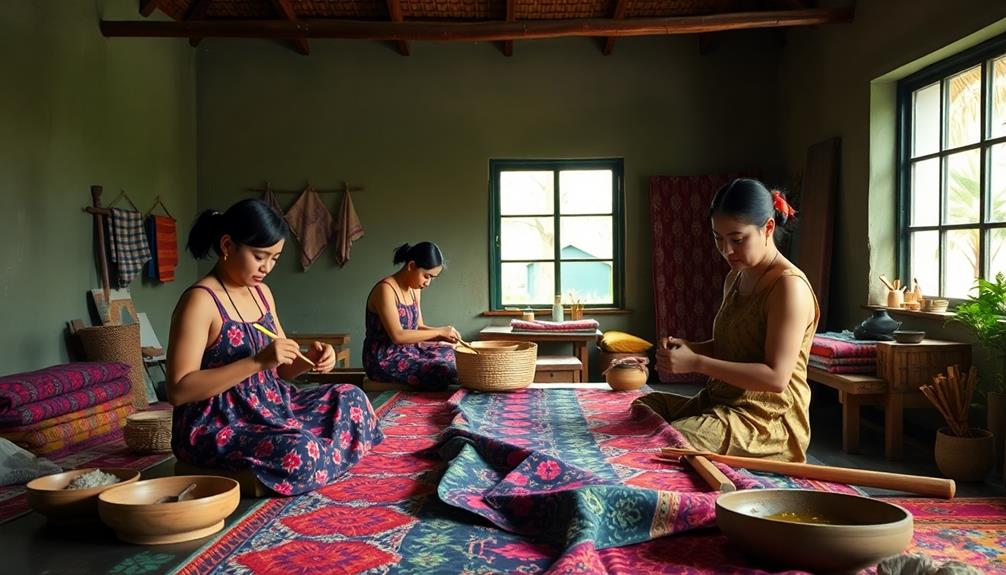
As you explore the fascinating world of batik creation, you'll discover a meticulous process that transforms plain fabrics into stunning works of art.
The process of creating batik begins with natural fabrics like cotton or silk, which are carefully stretched on a frame. This preparation is essential for the intricate designs that will follow. Skilled artisans often incorporate unique designs that reflect traditional artistry and local traditions, adding depth to each fabric.
Using a canting tool, artisans apply hot wax to outline the detailed batik patterns. This wax application serves as a resist during the dyeing process, allowing certain areas to remain untouched by color.
Once the wax is applied, the fabric is immersed in a dye bath, saturating it with vibrant colors. After dyeing, the fabric is dried to set the dye, preserving the beauty of the colors.
The final step involves removing the wax through heating or boiling water, revealing the striking patterns that define the art of batik.
This craftsmanship behind batik requires skill and patience, blending traditional and modern elements to create one-of-a-kind fabrics. Each piece carries cultural significance and artistic value, making it a unique treasure in your decor.
Symbolism Behind Batik Patterns
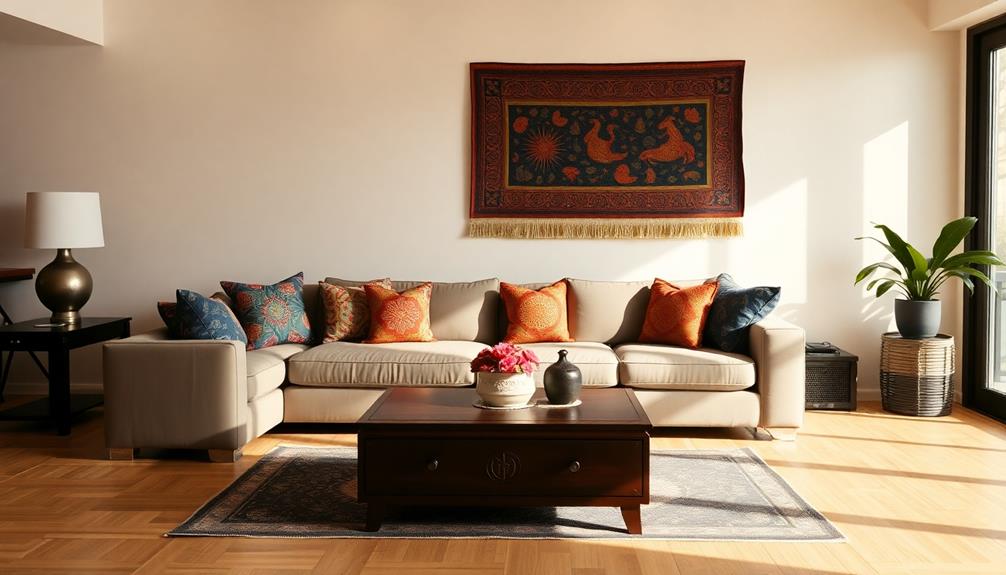
Batik patterns aren't just beautiful designs; they're steeped in rich symbolism that tells stories and conveys cultural messages. Each piece of fabric you encounter often carries significant meanings rooted in traditional Indonesian culture. For instance, the Parang pattern symbolizes power, protection, and bravery, while the Kawung design represents fertility, wealth, and prosperity.
These motifs aren't just decorative; they reflect the values and beliefs of the communities that created them. Additionally, incorporating Indonesian decorative pillows into your space can enhance the vibrancy of batik designs, creating a cohesive look that celebrates this rich heritage.
Moreover, Ceplok patterns, with their geometric forms, emphasize harmony and balance, resonating with Javanese philosophy. As you explore these designs, notice how each batik piece narrates a unique story, often inspired by nature, mythology, or social values.
This rich cultural value makes batik not only a textile but also a canvas of history and identity. Contemporary designers have embraced these traditions, infusing modern fashion with these age-old symbols.
Integrating Batik in Modern Spaces
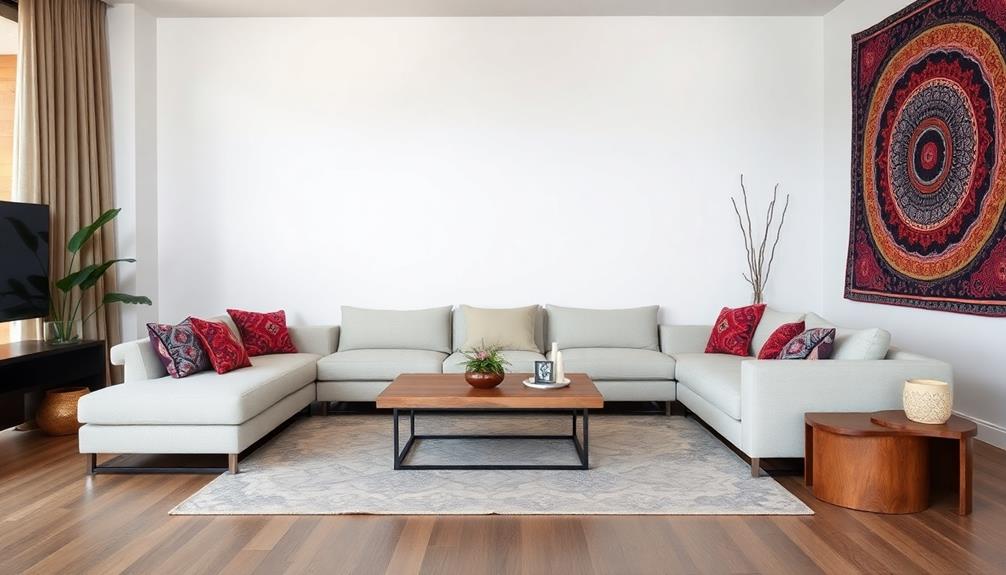
When you integrate batik into your modern space, pay attention to color schemes that harmonize rich batik hues with neutral tones.
Incorporating elements of traditional Indonesian style home decor can enhance the overall aesthetic.
Mixing textures can create a beautiful balance, enhancing the visual interest of your decor.
Harmonizing Color Schemes
Integrating batik patterns into modern decor can be a delightful challenge, especially when it comes to harmonizing color schemes. To achieve this, focus on selecting complementary shades that enhance the vibrant hues of the batik while blending seamlessly with contemporary elements.
Neutral tones like whites, grays, and beiges serve as effective backdrops, allowing the intricate designs of batik to shine without overwhelming the space. Incorporating elements of Indonesian artistry, such as the rich cultural heritage represented in Indonesian decor masks, can further enrich your decor and create a dialogue between the traditional and the modern.
Consider incorporating a limited color palette that mirrors the dominant hues within the batik. This approach creates a cohesive look, ensuring that traditional patterns harmonize beautifully with modern furnishings.
You can also use batik fabrics in accent pieces, such as throw pillows or wall hangings, which gives you flexibility in adjusting the intensity of color and pattern, maintaining balanced decor throughout the room.
Layering textures can further enhance visual interest. Pair batik with sleek metals or natural woods to create a striking contrast that celebrates both the cultural significance of the batik designs and the sleekness of modern decor.
Textural Contrast and Balance
Adding batik patterns into modern spaces creates a striking textural contrast that enriches your decor. The vibrant, intricate designs of batik fabrics juxtapose beautifully against sleek, minimalist furnishings, making your home decor more dynamic.
By using batik as accent pieces—like throw pillows or wall hangings—you can introduce a pop of cultural richness without overwhelming the overall aesthetic. This approach aligns with Balinese design characteristics, which emphasize the connection to nature and traditional craftsmanship.
When selecting batik fabrics, consider subdued color palettes to enhance modern decor. These options provide subtle yet distinct visual interest that complements the clean lines of contemporary furniture.
Additionally, incorporating batik table runners or curtains can introduce warmth and personality to otherwise stark environments, bridging the gap between traditional craftsmanship and modern style.
Layering batik textiles with materials like metal or glass enhances the tactile experience of a room. This approach not only creates a balanced atmosphere but also celebrates the beauty of both modernity and tradition.
With thoughtful integration of batik patterns on the fabric, you'll find that your space becomes a harmonious blend of cultural heritage and contemporary flair, elevating your home decor to new heights. The rich textures and intricate designs in the perfect batik patterns for home can bring a timeless and artistic touch to any room, infusing it with character and warmth. Whether you choose bold or subtle motifs, these patterns effortlessly complement both traditional and modern aesthetics, making your space feel uniquely yours.
Choosing the Right Batik Fabrics
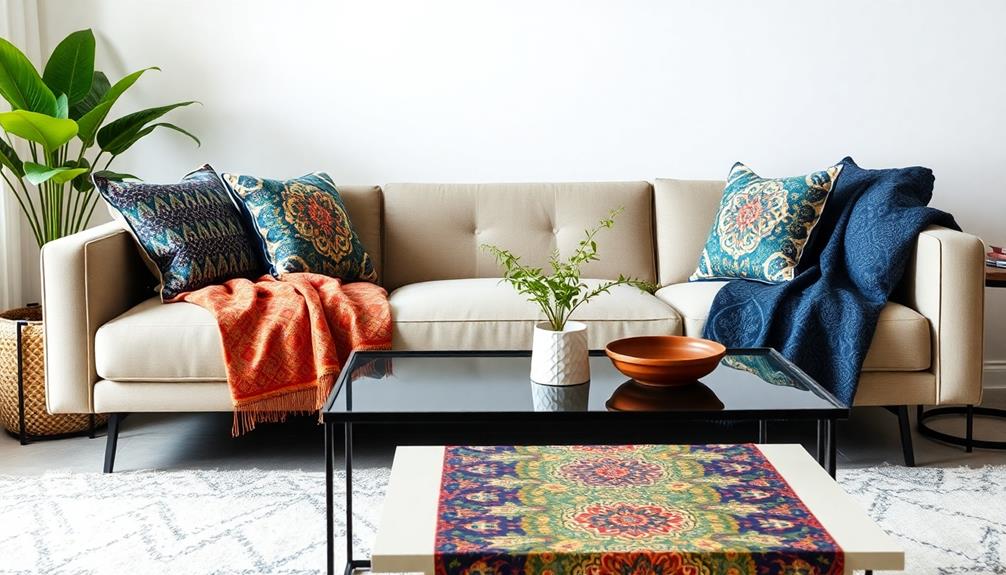
When choosing batik fabrics, consider their types and durability to guarantee they fit your lifestyle.
Incorporating elements of traditional design can enhance the beauty of your decor while staying true to your modern aesthetic.
Think about how the colors of your selected fabrics will blend with your existing decor and create a cohesive look.
Fabric Types and Durability
Choosing the right batik fabrics often involves considering both their material and durability. Prioritize fabric choices that feature natural materials like cotton or silk, as these provide breathability and long-lasting wear, making them perfect for everyday use.
Additionally, incorporating eco-friendly practices in your home decor, such as selecting eco-friendly materials, can enhance the overall aesthetic while promoting sustainability. Opt for high-quality batik fabrics that utilize eco-friendly natural dyes, which not only enhance the vibrancy of the intricate designs but also promote sustainable practices.
When evaluating your options, pay attention to the weight of the fabric. Lighter batik fabrics are ideal for traditional garments and drapery, while heavier options work well for upholstery and quilts.
Additionally, consider the thread count and weave; higher thread counts typically indicate better durability, ensuring your fabric stands the test of time.
Color Palette Considerations
Selecting the right batik fabrics goes beyond just material and durability; color plays a significant role in achieving a cohesive look in your modern decor. Start by choosing a focal batik piece that resonates with your desired color palette and emotional impact. This will set the tone for the entire arrangement. Complement your focal fabric by selecting fat quarters in dominant colors that echo its hues, ensuring harmony throughout your decor.
To create visual interest, incorporate contrast colors from your focal fabric while ensuring they enhance rather than clash with the intricate patterns. Tonal batik pieces can also be utilized to support your decor without overwhelming the main focal prints, maintaining a balanced aesthetic.
Here's a table to help you visualize your options:
| Focal Batik Color | Complementary Color | Tonal Batik |
|---|---|---|
| Rich Indigo | Soft Mustard | Light Blue |
| Warm Terracotta | Deep Olive | Beige |
| Bright Coral | Muted Teal | Light Gray |
| Classic Black | Vibrant Yellow | Charcoal |
Pattern Selection and Harmony
To achieve harmony in your decor, it's important to thoughtfully consider the patterns of your chosen batik fabrics. Start by selecting a focal batik fabric that resonates with you—this will be the centerpiece of your design. Guarantee it captures attention while maintaining a sense of balance within the space.
When choosing additional batik fabrics, opt for fat quarters in dominant colors that complement your focal fabric, creating a cohesive color palette. Incorporating elements from luxury tropical design aesthetics can also elevate your overall look.
Incorporate tonal batik pieces to enhance your overall design and allow the intricate designs of your focal fabric to shine. This approach maintains visual balance throughout your decor. Avoid using excessive large squares in your selections, as they can distract from the subtle beauty of traditional batik patterns; instead, focus on smaller pieces that add delicate accents.
Consider the scale and complexity of the patterns, too. Larger, bold prints work best in open areas, while smaller, detailed patterns can elevate the charm of intimate spaces.
Styling Tips for Batik Decor
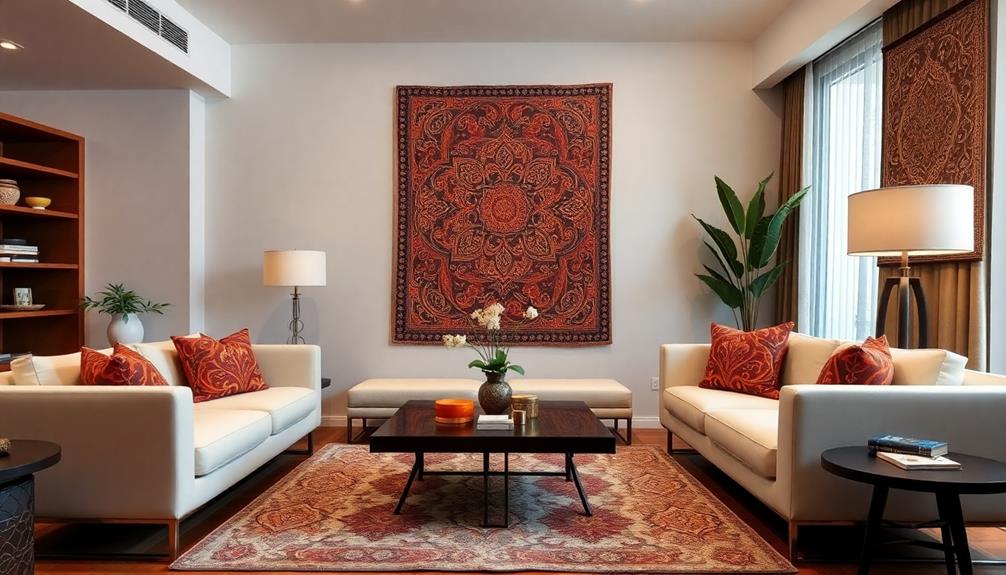
When it comes to styling your space with batik decor, think about incorporating these vibrant patterns as statement pieces. By using batik patterns, you can add a cultural flair that enhances your modern aesthetic without compromising style.
Reflect on blending these patterns with elements from Indonesian wedding decor ideas to elevate your design. Here are some effective styling tips to reflect on:
- Use throw pillows or wall hangings: These can act as focal points, drawing attention to the intricate designs while maintaining a balanced environment.
- Pair batik fabrics with neutral palettes: This helps highlight the richness of batik without overwhelming your space, allowing traditional elements to shine.
- Incorporate batik table runners or placemats: These blend beautifully with contemporary tableware, making your dining area feel inviting and stylish.
- Layer textiles thoughtfully: Use batik curtains or bedspreads alongside solid colors to create depth and texture, letting the patterns stand out.
Sustainable Practices in Batik
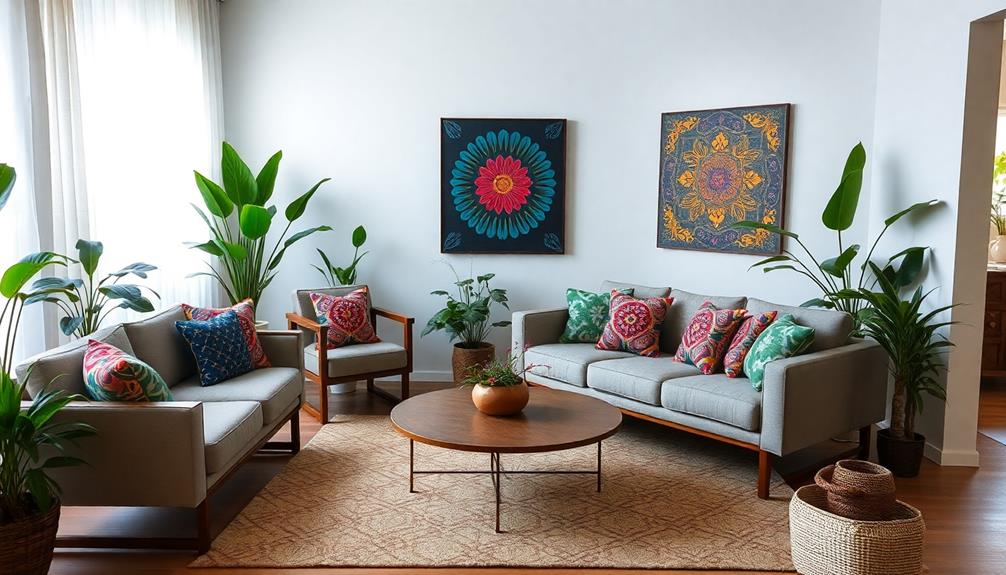
Batik decor not only adds a cultural touch to your space but also embraces sustainability through its production practices. By using locally sourced fabrics, batik artisans support local economies and considerably reduce the carbon footprint associated with transportation. This commitment to sustainable practices guarantees that your decor isn't just beautiful but also environmentally friendly.
One of the standout features of batik production is the use of natural dyes derived from plants, roots, and minerals. These natural dyes are a great alternative to synthetic options, making the dyeing process more eco-conscious.
Furthermore, many batik makers prioritize ethical manufacturing, guaranteeing fair wages and safe working conditions for artisans.
Community workshops and educational programs play an essential role in preserving traditional batik-making techniques while promoting sustainable practices among younger generations. By participating in these initiatives, you can connect with the art form and learn how to appreciate its environmental implications.
As demand for sustainable fashion choices grows, integrating batik into your decor not only enhances your space but also supports a broader movement towards ethical and environmentally sound production methods. This makes your decor choice not just aesthetic, but also responsible.
Celebrating Heritage Through Design
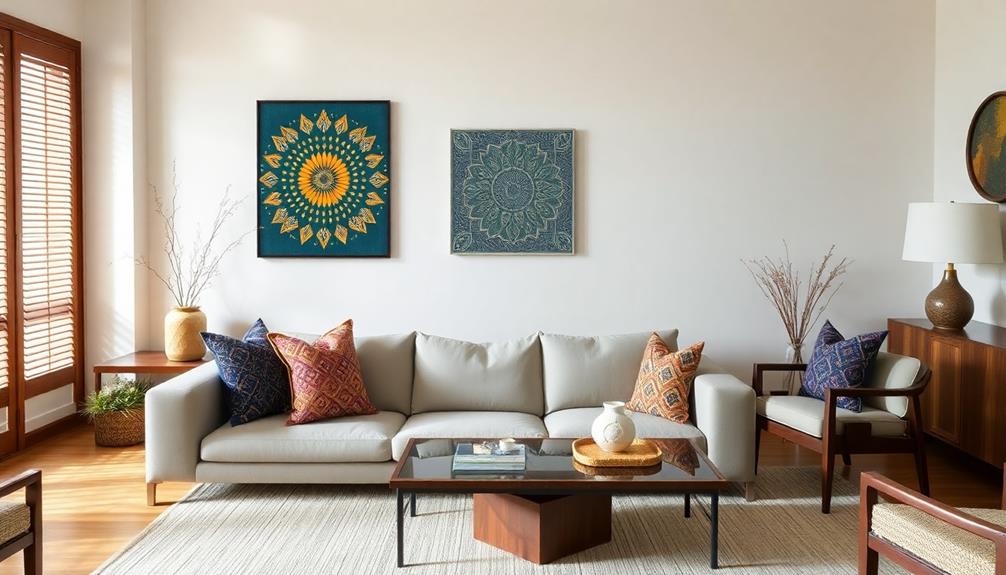
Integrating traditional batik patterns into your decor not only honors cultural heritage but also brings unique artistic elements into modern spaces.
By incorporating these designs, you're creating a beautiful dialogue between past and present, enriching your home with stories and meanings.
Here are four ways to celebrate your heritage through design:
- Cushions and Throws: Use batik fabrics for cushions or throws on minimalist furniture to create a striking contrast that elevates your decor.
- Wall Hangings: Choose batik wall hangings that serve as focal points, showcasing intricate patterns that reflect your cultural roots.
- Table Linens: Incorporate batik table runners or placemats during gatherings, sparking conversations about the artistry and heritage behind the designs.
- Art Pieces: Look for framed batik art that tells a story, allowing you to express your appreciation for traditional art while complementing modern aesthetics.
Frequently Asked Questions
What Is the Modern Pattern of Batik?
Modern batik patterns often blend contemporary motifs with traditional techniques, featuring vibrant colors and abstract designs. You'll find geometric shapes replacing historical representations, making these fabrics versatile for both fashion and home decor.
What Is the Basis of Modern Batik Design?
Modern batik design blends traditional techniques with contemporary motifs, utilizing innovative color palettes and digital printing. You'll find sustainability at its core, as artists prioritize eco-friendly materials while appealing to today's diverse fashion sensibilities.
What Is the Traditional Batik Technique?
Ever thought about how art transforms fabric? The traditional batik technique involves applying hot wax to fabric, creating intricate patterns. After dyeing, you remove the wax, revealing vibrant designs steeped in cultural significance.
What Are the 5 Major Types of Batik Design?
You'll find five major batik designs: Parang for strength, Kawung for prosperity, Ceplok for harmony, Mega Mendung for hope, and Batik Tulis, which captures unique stories through its handcrafted techniques. Each design holds rich cultural significance.
Conclusion
Embracing batik in your modern decor doesn't mean sacrificing your contemporary style. You can seamlessly blend these rich, traditional patterns with sleek, modern elements to create a unique space that tells a story. Don't worry if you think batik is too bold; when done thoughtfully, it adds depth and character without overwhelming your design. By integrating these vibrant fabrics, you celebrate heritage while crafting a fresh, inviting atmosphere that reflects both your personality and your appreciation for culture.
Decor
Why Feng Shui Should Be Your Next Design Move for a Perfect Home
Just imagine transforming your home into a serene sanctuary; discover how Feng Shui can unlock a harmonious living experience.
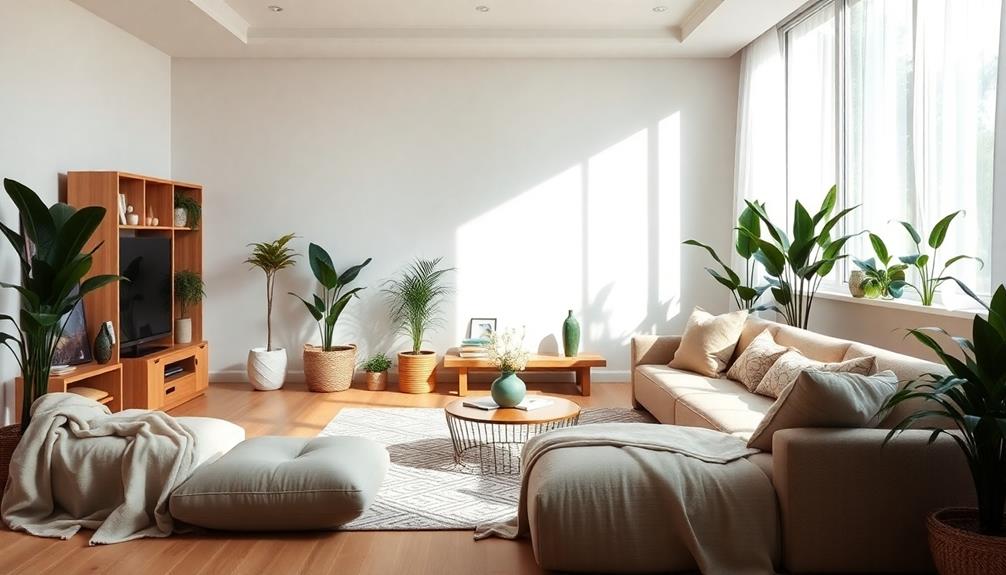
Considering Feng Shui for your home design can be a game changer. It creates a balanced environment that promotes positive energy flow, enhancing your mood and well-being. By decluttering and organizing your space, you can clear the pathways for Chi, leading to improved clarity and calm. Thoughtful arrangement of furniture not only boosts comfort but also encourages social interaction. When you harness natural light and incorporate earthy elements, you uplift the atmosphere in your living space. Ready to transform your home into a harmonious sanctuary? There's plenty more to explore about how Feng Shui can reshape your living experience.
Key Takeaways
- Feng Shui creates harmonious living environments by optimizing energy flow, enhancing emotional and physical well-being.
- Regular decluttering practices promote mental clarity and a sense of calm, essential for a perfect home.
- Thoughtful furniture arrangement encourages chi movement, ensuring inviting and functional spaces throughout your home.
- Incorporating natural elements and light elevates mood and energy levels, contributing to a more uplifting atmosphere.
- Addressing energy imbalances through Feng Shui fosters peace, stability, and overall balance in your living environment.
Understanding Feng Shui Basics
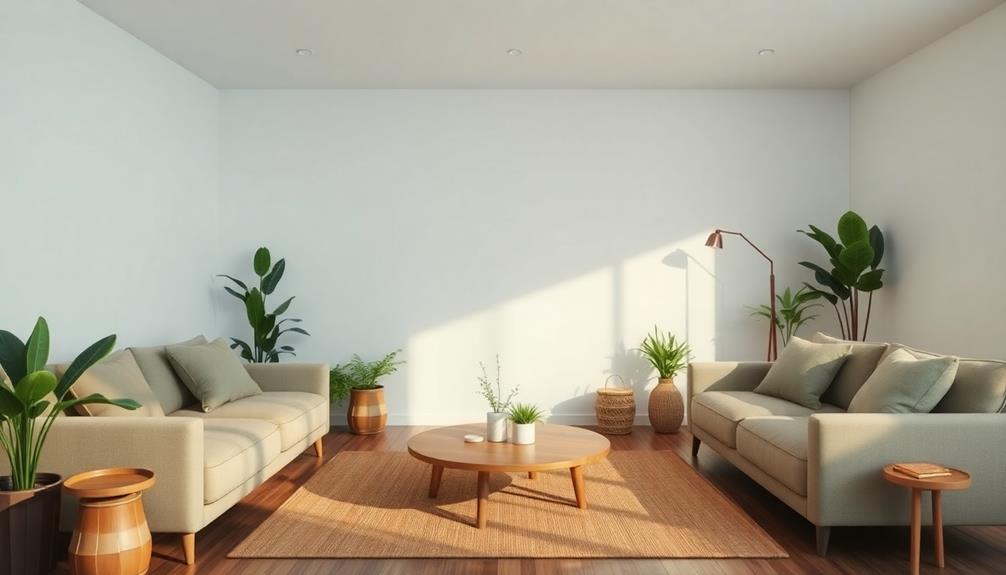
Feng Shui is more than just a trend; it's an ancient practice that helps you create a harmonious living environment. At its core, Feng Shui focuses on the flow of energy, known as Chi, which influences your mood and overall well-being. Embracing the principles of Feng Shui means understanding how to enhance good Feng Shui in your space.
One of the key elements is keeping your home clutter-free. By decluttering, you allow energy to circulate freely, promoting mental clarity and reducing stress.
Additionally, achieving balance between Yin and Yang is essential; this harmony fosters a sense of peace in your surroundings. Incorporating natural materials and earth tones, much like in Balinese interior design, can enhance this balance and connection to nature.
Natural light and fresh air are crucial components that support good Chi. Incorporating these elements can greatly uplift the energy in your home.
You can also utilize the Bagua Map to identify areas of your life you want to enhance, such as wealth or love, and align your space accordingly.
Recognizing Energy Imbalances
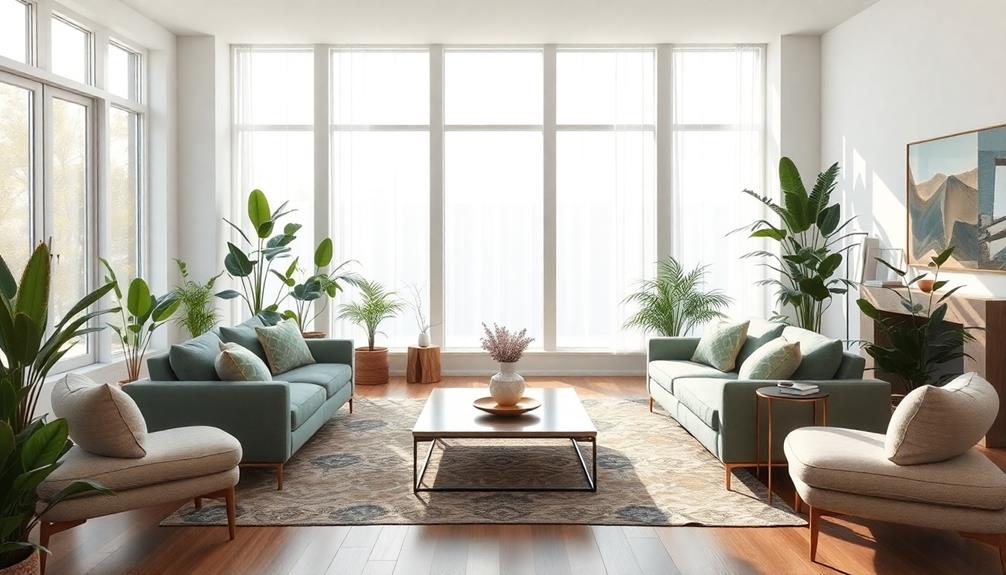
Recognizing energy imbalances in your home is essential for maintaining a positive and uplifting environment. When you notice feelings of lethargy or depression, it might signal an excess of water or a shortage of fire elements in your space.
Similarly, instability and hyperactivity can arise from the lack of earth elements, highlighting the need for balanced elemental representation to foster a sense of grounding. Incorporating Indonesian decorative pillows with vibrant colors and intricate patterns can help enhance the energy of a room, making it more inviting and comfortable.
An overabundance of fire elements can lead to impulsiveness and anxiety, which means you may need to adjust your decor to create a calmer atmosphere. If your relationships feel strained, it could be due to insufficient earth elements. Incorporating grounding materials or colors can enhance connection and harmony among those who share your space.
Clutter is another significant factor; it often brings chaos and indecisiveness, disrupting the natural flow of energy. Managing clutter is important for maintaining balance, as it hinders progress and can prevent positive energy from circulating throughout your home.
Effective Space Organization
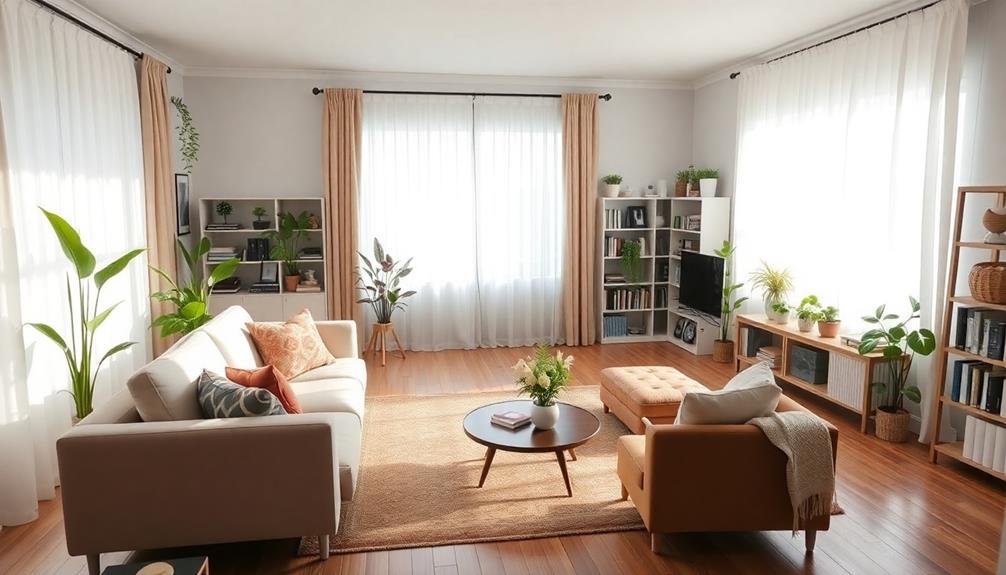
When you organize your space effectively, you create an environment that supports your goals and enhances your well-being. By Feng Shui-ing your home according to the Bagua Map, you can align specific areas with your personal aspirations.
Start by ensuring clear pathways throughout your space; this not only promotes better energy circulation but also makes your home inviting. Incorporating elements of traditional Indonesian style can further enhance your space, as it emphasizes harmony with nature and promotes a relaxed atmosphere.
Avoid clutter near doorways, as it can block the flow of chi. Thoughtful furniture arrangement is key. Choose appropriately sized pieces and maintain balanced placement to foster comfort and encourage social interaction. This arrangement can transform your space from merely functional to a harmonious gathering spot.
Incorporating natural elements, like plants and wood materials, beautifies your environment while improving air quality. These elements bring tranquility and a sense of grounding, enriching your living experience.
Don't forget to declutter regularly, especially in entryways and common areas. A tidy space reduces chaos and promotes mental clarity.
Room-Specific Feng Shui Tips
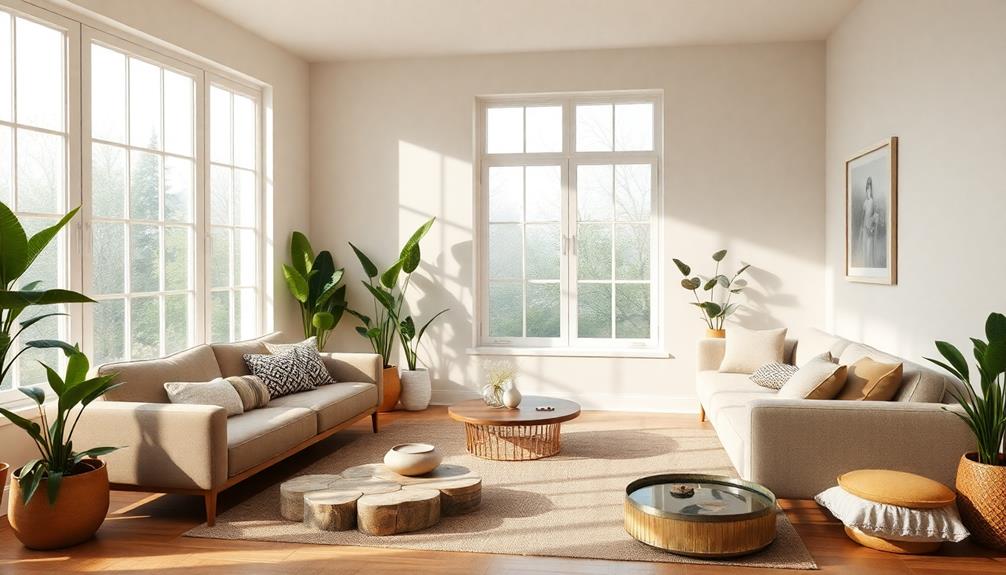
Transforming your home with room-specific Feng Shui tips can greatly enhance the flow of energy in your living space. Start with the living room: Arrange your furniture to encourage good energy by anchoring pieces against a solid wall and creating space for movement and conversation. For your dining room, choose a round or square table to promote equality among family members. Don't forget to add some plants—these bring life and vibrancy to your environment!
At your front door, keep it well-maintained and clutter-free, as it symbolizes the entry point for wealth and opportunities. In the bedroom, position your bed against a solid wall opposite the door to foster security and restful energy. Avoid placing mirrors that reflect the bed, as they can disrupt your peace.
Lastly, maintain cleanliness in the bathroom and keep the toilet lid closed to prevent the drainage of wealth and energy from your home.
| Room | Feng Shui Tip |
|---|---|
| Living Room | Arrange furniture for good energy flow |
| Dining Room | Use round or square tables |
| Bedroom | Position bed against a solid wall |
Clutter Management Strategies
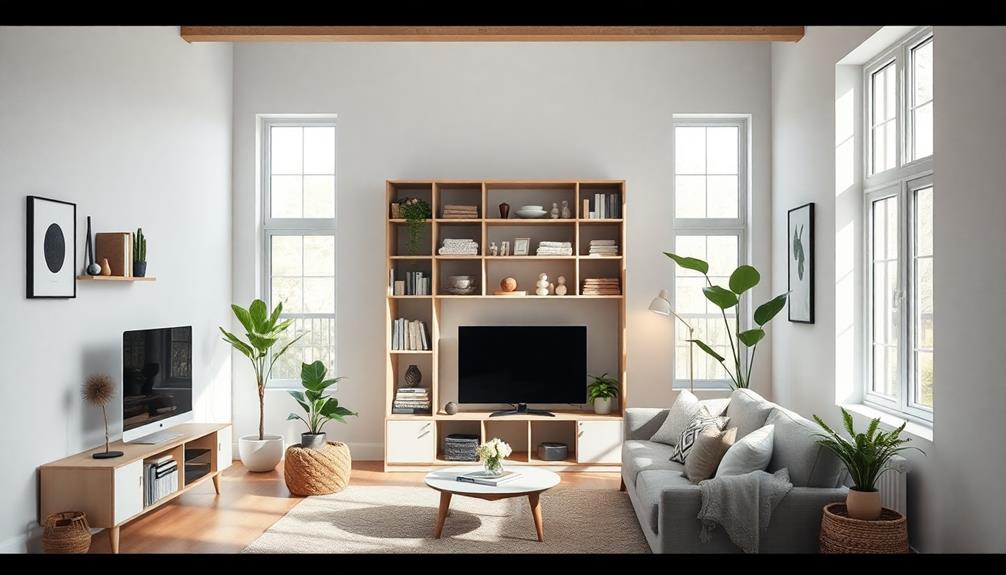
To create a harmonious space, tackle entryway clutter first; it sets the tone for your entire home.
Emphasizing minimalism not only simplifies your entryway but also fosters a safe and inviting atmosphere for both you and your guests.
Regular cleaning practices not only keep your environment tidy but also boost your mental clarity, especially when combined with space maximization and organization hacks.
Entryway Clutter Solutions
An entryway brimming with clutter not only hinders the flow of energy (chi) but also sets a chaotic tone for your entire home. To create a positive atmosphere, start by addressing common clutter items like shoes and bags.
Designate specific storage solutions, such as baskets or shelves, to guarantee everything has its place. By returning items to these designated spots, you'll greatly improve the energy flow in your entryway. Incorporating eco-friendly room decor can also enhance the space, promoting a sense of calm and sustainability.
Consider repurposing furniture, like using a bench with hidden storage or a console table for organizing keys and mail. This not only keeps your entryway tidy but also adds functional flair to the space.
Make decluttering a priority; regularly assess your belongings and remove any items that don't serve a purpose or contribute positively to your life.
If you tackle major annoyances—like overflowing shoe racks or piles of bags—you'll maximize energy flow and set a welcoming tone for the rest of your home. A clean, organized entryway invites opportunities and good vibes to enter your life, making it an essential aspect of your overall Feng Shui journey.
Regular Cleaning Practices
Consistency in cleaning practices is vital for maintaining a harmonious home environment. Regularly decluttering not only enhances energy flow but also greatly reduces stress. Clutter symbolizes indecisiveness and hinders your progress in life, so prioritize cleaning areas like entryways, bedrooms, and common living spaces. These zones profoundly influence your home's overall energy and ambiance.
To keep your space organized, implement a routine for evaluating belongings. Verify each item has a designated place to promote positive energy. Here's a simple table to help you manage your cleaning and decluttering efforts:
| Task | Frequency |
|---|---|
| Declutter entryway | Weekly |
| Organize bedroom | Bi-weekly |
| Clean common areas | Weekly |
| Evaluate storage solutions | Monthly |
| Address major annoyances | As needed |
Utilize creative storage solutions, like repurposing furniture, especially near the entrance where energy flow is critical. By tackling major annoyances, like overflowing storage areas, you free up energy for further improvements in your home. Embrace these cleaning practices to create a serene and positive living space.
Enhancing Overall Home Energy
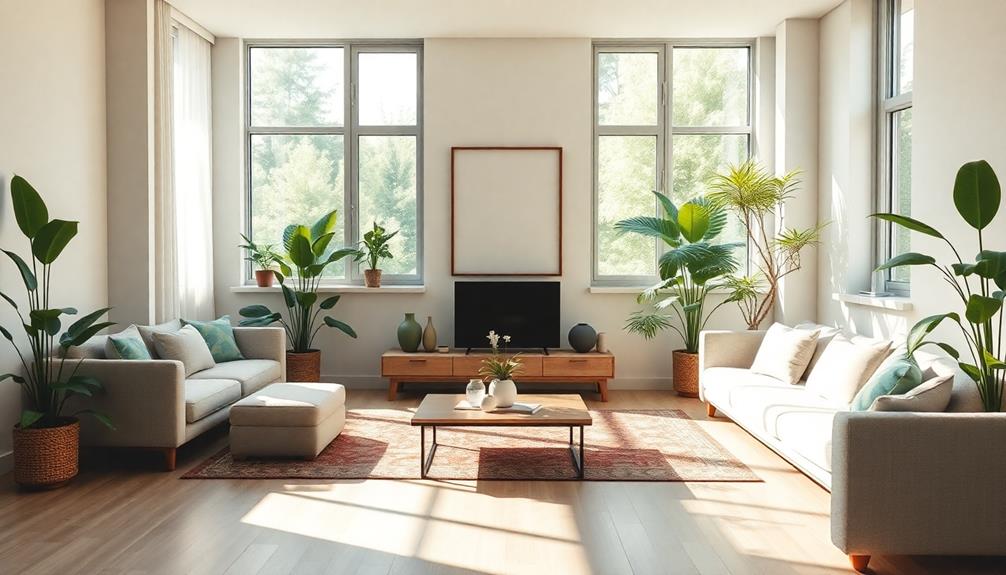
Harmony in your home can greatly enhance overall energy, creating a space that promotes emotional and physical well-being. To achieve this, focus on enhancing overall home energy by optimizing the flow of chi.
Start by incorporating natural light; it considerably boosts mood and energy levels, making your living environment healthier. In many traditional Indonesian homes, the architectural style often integrates natural elements, fostering a connection between the indoors and outdoors, which can further enhance this energy flow traditional Indonesian housing.
Regular decluttering is also essential. Clutter symbolizes indecisiveness and can hinder progress, leading to feelings of chaos. By keeping your space tidy, you allow positive energy to flow freely.
Next, pay attention to your furniture arrangement. Position your items to avoid blockages, guaranteeing chi can circulate throughout your home. This mindful arrangement not only improves energy flow but also encourages a sense of tranquility.
Frequently Asked Questions
What Is the Best Feng Shui Orientation for a House?
The best Feng Shui orientation for your house is often south-facing, maximizing sunlight and positive energy. North-facing homes promote tranquility, while east-facing boosts vigor. Consider the surrounding landscape to enhance your home's energy flow.
How to Organize Your Home According to Feng Shui?
Organizing your home according to Feng Shui isn't just about aesthetics; it's about creating harmony. Start by decluttering, arranging furniture for flow, and incorporating natural elements to invite positive energy and enhance your well-being.
What Is Bad Feng Shui for a House?
Bad Feng Shui in your house often stems from clutter, poor furniture placement, and insufficient natural light. Mirrors facing the bed and damaged front doors can also disrupt energy flow, impacting your well-being and opportunities.
When Should I Move My House Feng Shui?
Did you know that 85% of people feel more energized in spaces with balanced Feng Shui? If you're feeling lethargic, chaotic, or emotionally disconnected, it's time to contemplate moving your house Feng Shui for better harmony.
Conclusion
So, if you're ready to rearrange your furniture based on ancient Chinese wisdom instead of your personal taste, go ahead! Embrace the mystical art of feng shui and watch your home transform into a harmonious haven—or at least a Pinterest-worthy gallery. Just remember, while you're aligning your crystals and decluttering your junk drawer, your cat might have other plans. Who knew your feline overlord would be the real feng shui master? Good luck with that!
Decor
7 Proven Feng Shui Tips for a Relaxed and Harmonious Space
Harness the power of Feng Shui with these 7 proven tips for a relaxed and harmonious space—discover what transforms your environment into a tranquil retreat.

Transform your space into a haven of calm with these Feng Shui tips. Start by decluttering to boost positive energy flow. Embrace soft, neutral color palettes to create a serene atmosphere. Adding live plants not only enhances air quality but also invites tranquility. Optimize your lighting with soft, warm sources to make your environment inviting. Establish a focal point to guide energy effectively, and consider water elements like small fountains for added calmness. Finally, choose comfortable furniture that enhances relaxation and movement. There's so much more to explore to elevate your space further—let's delve into the details!
Key Takeaways
- Declutter your space to enhance the flow of chi, reducing stagnation and fostering mental clarity and relaxation.
- Use soft color palettes and neutral hues to create a calm atmosphere that promotes tranquility and emotional well-being.
- Integrate live plants to improve air quality and invite positive energy while enhancing the serene environment.
- Optimize lighting with soft, adjustable sources to create a warm ambiance and eliminate harsh shadows for a calming effect.
- Establish a focal point that captivates attention and directs energy flow, enhancing the overall aesthetic and harmony of the space.
Declutter for Positive Energy
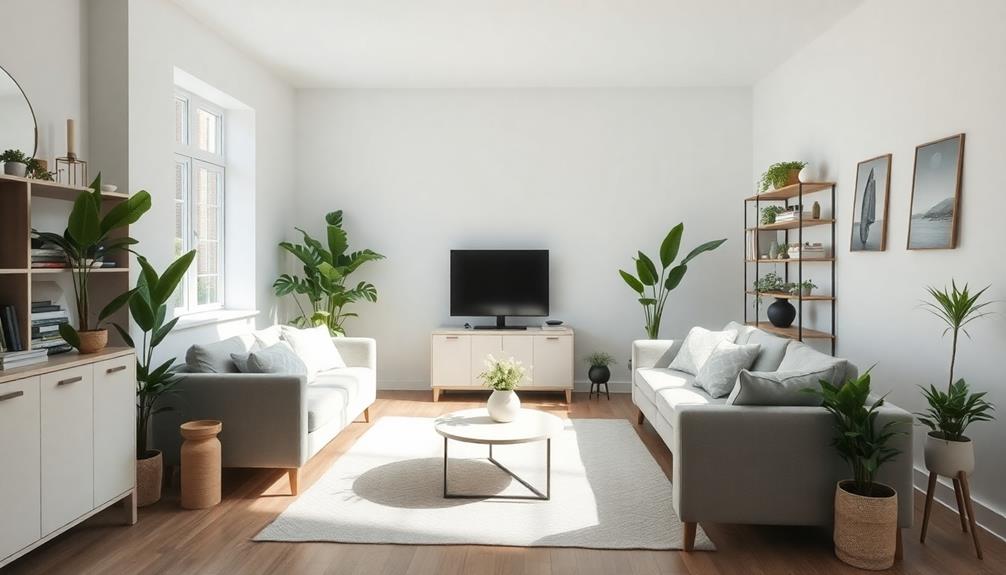
To achieve a relaxed space, you need to declutter for positive energy. Incorporating elements of Indonesian decorative pillows can enhance your living area with vibrant colors and patterns, making it visually appealing while also promoting comfort.
Regularly removing items that block chi creates a smoother flow of energy, enhancing the overall ambiance of your home. When your environment is free of clutter, it reduces stagnation and promotes relaxation, allowing you to focus better and experience mental clarity.
Feng Shui principles emphasize that every item in your space should serve a purpose or bring you joy. If it doesn't, it's time to let it go. Conducting space clearings regularly helps maintain a harmonious atmosphere, ensuring that energy remains vibrant and uplifting.
This practice not only fosters a harmonious home but also greatly reduces stress and anxiety, improving your mental and emotional well-being.
As you declutter for positive energy, think about how each space feels. You'll find that a clutter-free environment cultivates tranquility, allowing you to enjoy your surroundings fully.
Embrace the simplicity and effectiveness of creating a harmonious environment, and watch as your life transforms in response to the energy you invite in. Prioritize this essential step, and you'll lay the foundation for a truly relaxed and inviting space.
Embrace Soft Color Palettes

To create a truly calming environment, you should embrace soft color palettes in your space.
Neutral hues like beige and pale blue promote tranquility, while pastels can add gentle accents that enhance the overall ambiance.
Incorporating earth tones, as seen in Balinese design characteristics, can further foster a connection to nature and serenity.
Calming Color Choices
Creating a serene environment starts with your color choices. In Feng Shui, soft color palettes, like pale blues and gentle greens, promote tranquility and relaxation, crucial for cultivating a calming atmosphere.
These hues not only enhance your space but also contribute to peaceful sleep and rejuvenation. You can complement these colors with traditional elements, such as Indonesian decor masks, which add vibrant artistry and cultural significance to your home.
Incorporating earthy colors such as beiges and soft browns can ground the energy in your room, fostering a nurturing environment. Avoid overly bright or saturated colors, particularly reds and oranges, since they can evoke agitation and anxiety. Instead, focus on pastel shades that reflect natural light, making your areas feel more open and inviting.
The strategic use of color placement is essential as well. Consider creating accent walls in soothing shades to draw attention while maintaining a harmonious flow of energy throughout your home.
These thoughtful color choices can create focal points that enhance the overall serenity of your space. By embracing these calming color choices, you'll transform your environment into a peaceful sanctuary that invites relaxation and comfort.
Neutral Hues Benefits
Embracing neutral hues in your space offers numerous benefits that enhance both aesthetics and well-being. Soft color palettes, like beige, pale blue, and soft greens, create a calm and serene atmosphere, allowing you to relax and unwind. These hues not only reduce stress levels but also improve mood, promoting emotional well-being. Incorporating elements of coastal color palettes can additionally elevate the tranquility in your room.
By incorporating neutral colors, you help reflect natural light, brightening your rooms while maintaining a soothing ambiance. This combination encourages tranquility and enhances your overall living experience. Moreover, using soft colors provides flexibility in your design choices, enabling you to add various decorative elements without overwhelming your senses.
In the context of Feng Shui, neutral hues play an important role in creating balance and harmony. They prevent visual clutter, supporting the free flow of chi throughout your environment.
When your space feels balanced, it cultivates a sense of peace and harmony, which is essential for your well-being.
Accentuate With Pastels
While you may want to infuse your space with a sense of calm, incorporating pastel colors can greatly enhance the overall tranquility of your home. Soft pastel colors like pale blue, lavender, and soft green promote tranquility and calmness, creating a relaxed atmosphere that encourages serenity and comfort.
By using a pastel color palette, you foster a positive energy flow, as these hues are less jarring than brighter shades. To create a harmonious look, consider incorporating pastels in wall colors, furniture, and accessories, as well as incorporating Scandinavian charm in kid-friendly homes to maintain a clutter-free environment. This cohesive approach invites relaxation and peace into your environment.
When paired with natural textures, such as wood or soft fabrics, pastel colors elevate the ambiance, making your space feel nurturing and inviting for both residents and guests.
Integrating these soothing tones can remarkably reduce feelings of anxiety and stress, contributing to improved mental well-being. Embrace soft textures alongside your pastel palette to further enhance the serene atmosphere.
Integrate Live Plants
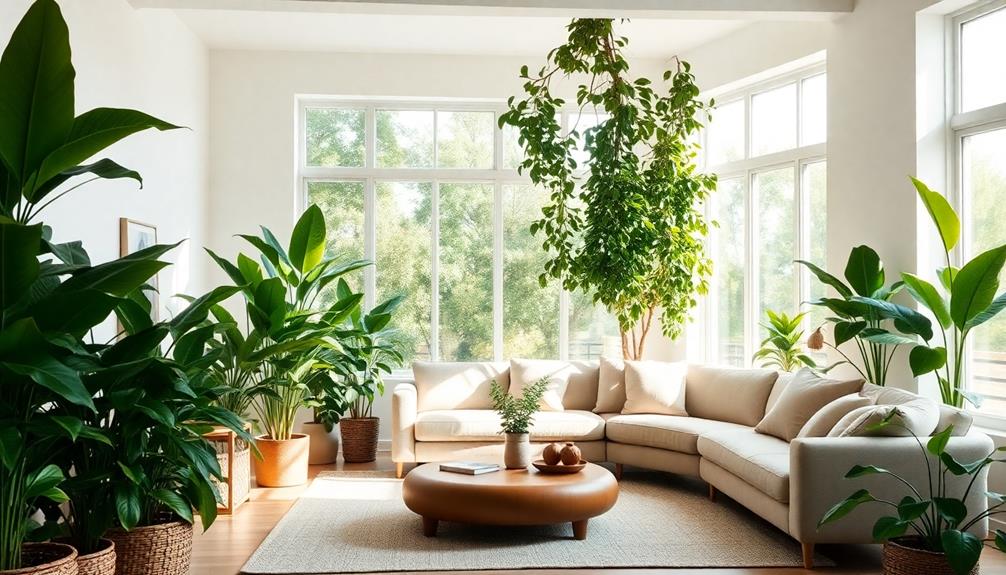
Incorporating live plants into your home regularly enhances both air quality and overall aesthetics. Not only do they filter toxins and boost oxygen levels, but they also create a healthier living environment.
Plants like peace lilies, snake plants, and pothos are perfect due to their low maintenance and adaptability to various lighting conditions. Additionally, these plants can act as natural sound barriers, contributing to a quieter and more serene atmosphere improve air quality.
According to Feng Shui principles, plants symbolize growth and prosperity, which helps promote positive energy throughout your space. By incorporating live plants, you encourage a harmonious flow that contributes to a sense of calmness and tranquility.
Opt for a variety of plants, especially those with rounded leaves, to amplify that peaceful atmosphere.
To maximize their benefits, position your plants in areas where you can easily see and appreciate them, such as near windows or in entryways. This not only invites positive energy into your home but also enhances your overall well-being.
Optimize Lighting Choices
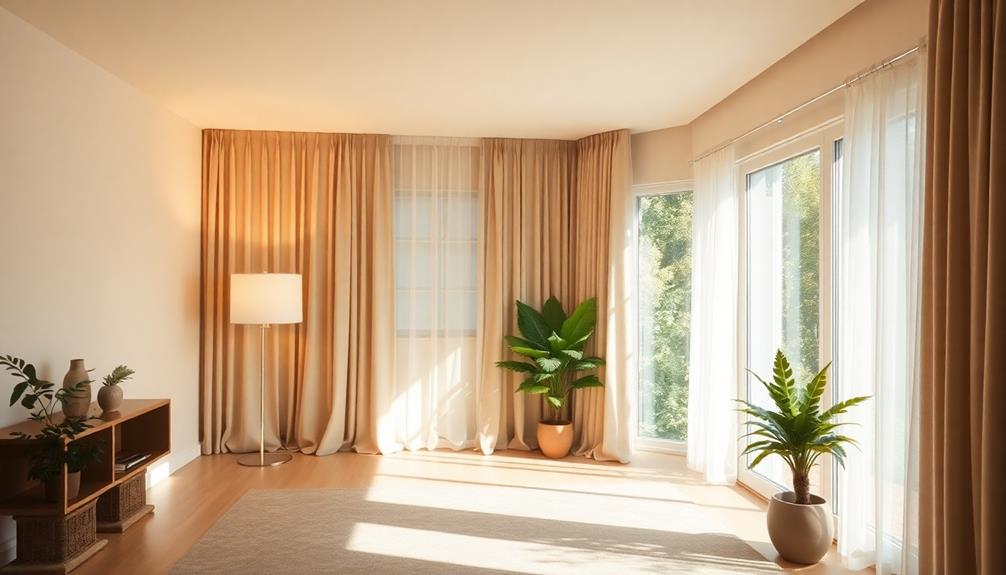
To create a relaxed space, you should focus on soft lighting effects that foster calmness and enhance energy flow.
Incorporating elements from luxury tropical design aesthetics can further elevate the ambiance.
Position table lamps strategically around the room to create a warm, inviting atmosphere.
Soft Lighting Effects
At the end of a long day, soft lighting can transform your space into a sanctuary of relaxation.
It's essential for creating a calming atmosphere, particularly in bedrooms and living rooms where comfort is key.
By choosing the right lighting, you can foster a peaceful and harmonious environment that enhances your overall well-being.
Incorporating natural materials in your decor, as seen in luxury tropical designs, can further elevate the soothing ambiance.
Here are some tips for optimizing soft lighting:
- Use Dimmers: Adjustable light intensity allows you to tailor the ambiance to your mood, promoting better energy flow throughout your space.
- Incorporate Multiple Light Sources: Combining lamps, sconces, and candles creates layers of light that add depth and warmth, making your home inviting.
- Choose Warm Color Temperatures: Light bulbs around 2700K to 3000K mimic natural sunlight, fostering tranquility and relaxation.
- Strategic Placement of Lighting Fixtures: Positioning lights carefully can eliminate harsh shadows and glare, contributing to a serene atmosphere.
Strategic Lamp Placement
Strategic lamp placement can considerably enhance the ambiance of your space, turning it into a haven of relaxation. Start by positioning your lamps to provide soft ambient lighting, which promotes comfort and tranquility.
To further enhance your environment, consider incorporating adjustable lighting for mood settings, as seen in smart home theater design. Avoid harsh overhead lights that disrupt the calming atmosphere you're aiming for. Using dimmer switches on your lamps lets you adjust brightness according to the time of day, creating either a tranquil or invigorating environment as needed.
Place lamps in corners to enhance the flow of chi, ensuring even light distribution throughout the room. This prevents dark spots that can generate feelings of unease. Incorporate lamps made with natural materials like wood or fabric shades to foster a calming atmosphere that resonates with Feng Shui principles.
Be mindful not to place lamps directly in line with doors or windows, as this can disrupt energy flow. Instead, opt for placements that encourage a smooth movement of chi within your space.
Establish a Focal Point
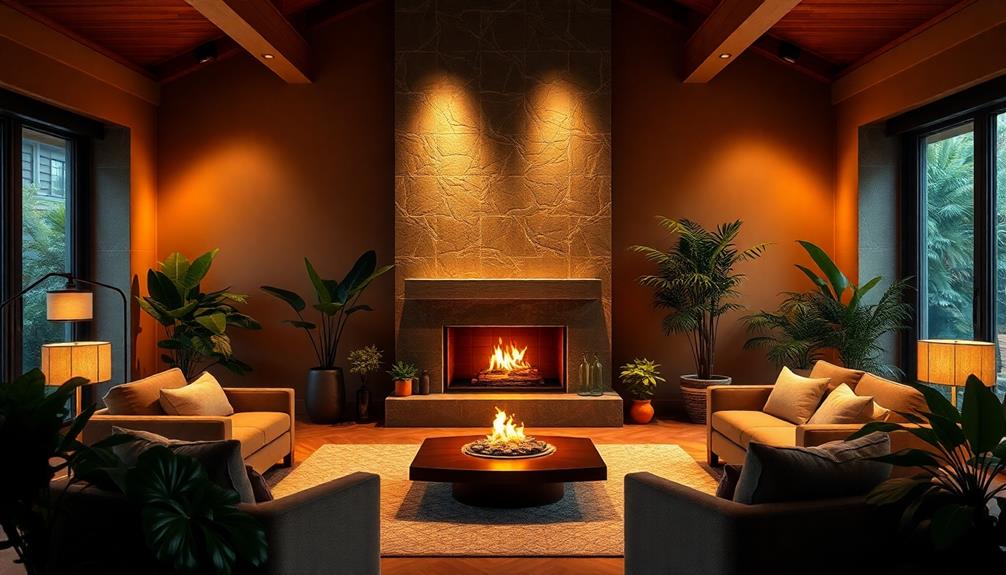
Creating a focal point in your space not only draws the eye but also establishes a sense of balance and harmony.
In traditional Indonesian style homes, for example, incorporating a striking artwork or an intricately carved furniture piece can enhance the aesthetic appeal while directing the flow of chi toward a specific area.
By doing so, you can improve the overall energy of your room, promoting a relaxed and harmonious atmosphere.
Here are some tips to effectively create a focal point:
- Choose a Statement Piece: Opt for a striking artwork or unique furniture that captivates attention.
- Position at Eye Level: Make certain your focal point is easily visible upon entering the room, ideally at eye level, to engage visitors instantly.
- Incorporate Natural Elements: Use plants or natural materials to enhance positive energy and create a calming atmosphere, reminiscent of Balinese indoor-outdoor living.
- Avoid Overcrowding: Keep the area surrounding your focal point clear. Too many decorative items can create visual chaos and disrupt the desired tranquility.
Incorporate Water Elements
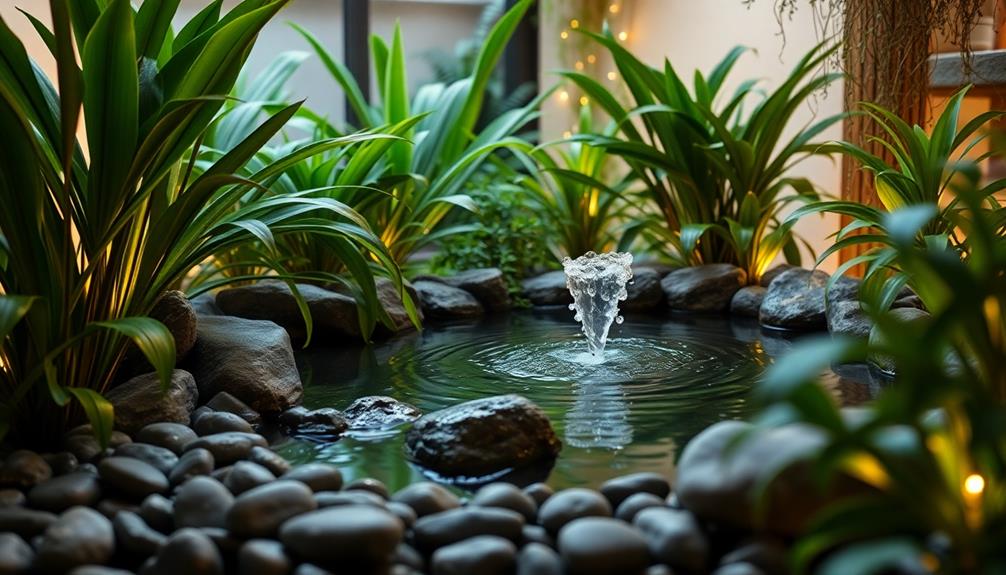
In addition to establishing a focal point, incorporating water elements can greatly enhance the tranquility of your space. Water features like fountains or aquariums not only attract positive energy (chi) but also symbolize wealth and abundance. The soothing sound of flowing water helps to create a calming atmosphere, reducing stress and enhancing your overall sense of tranquility.
Positioning these elements in your wealth corner—located in the farthest left corner from your entrance—can amplify financial opportunities and prosperity. However, it's essential to maintain clean and healthy water features, as stagnant or dirty water disrupts energy flow and invites negativity.
To guarantee balance and harmony, complement your water elements with plants and natural materials. This combination creates a serene environment, promoting relaxation and positivity.
Here's a quick overview of water elements to take into account:
| Water Element | Benefits | Placement Tips |
|---|---|---|
| Fountains | Attracts positive energy | Wealth corner |
| Aquariums | Symbolizes abundance | Living room or office |
| Indoor ponds | Enhances tranquility | Backyard or garden |
| Water bowls | Good for small spaces | On a table or shelf |
Choose Comfortable Furniture
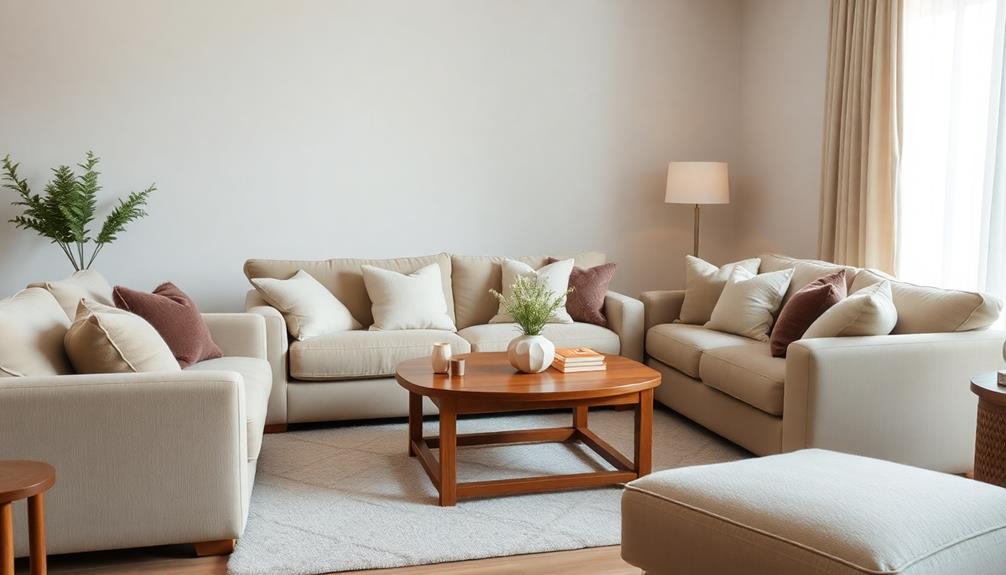
Choosing comfortable furniture is essential for crafting a relaxed space where you can unwind. By prioritizing comfort, you not only promote relaxation but also create inviting spaces that enhance your well-being.
Here are some tips for selecting the right pieces:
- Opt for Ergonomic Designs: Guarantee your furniture, like plush sofas and cozy armchairs, supports your body to reduce physical strain.
- Incorporate Natural Textures: Choose materials such as wood and wool to enhance warmth and connection to nature, creating a harmonious environment.
- Mind Your Furniture Arrangement: Arrange your furniture to facilitate smooth movement and energy flow (chi) throughout the space, avoiding blockages.
- Select Rounded Edges: Furniture with rounded edges fosters smoother energy flow, reducing sharpness and promoting a nurturing atmosphere.
Frequently Asked Questions
How Does Feng Shui Affect Mental Health and Well-Being?
Feng Shui influences your mental health by creating environments that promote balance and tranquility. When you arrange your space mindfully, you'll feel more centered, reducing stress and enhancing your overall well-being and emotional clarity.
Can Feng Shui Principles Be Applied to Outdoor Spaces?
Absolutely, you can apply Feng Shui principles to outdoor spaces. By arranging plants, furniture, and pathways thoughtfully, you'll create a balanced environment that promotes relaxation and harmony, enhancing your overall well-being in your outdoor areas.
What Are Common Feng Shui Mistakes to Avoid?
When exploring common feng shui mistakes, you should avoid clutter, improper furniture placement, and ignoring natural elements. Don't underestimate the impact of color and lighting; they greatly influence energy flow in your space.
How Often Should I Refresh My Feng Shui Setup?
Did you know that 70% of people feel more balanced after revitalizing their space? You should revitalize your feng shui setup every season. This keeps energy flowing and helps maintain harmony in your environment.
Is There a Specific Direction for Arranging Furniture?
When arranging furniture, consider the room's flow. You'll want to create a welcoming atmosphere, so position pieces to encourage movement and balance. Trust your instincts; you'll feel the difference in energy and comfort.
Conclusion
By implementing these feng shui tips, you can transform your space into a sanctuary of relaxation and harmony. Remember, "A cluttered space equals a cluttered mind." So, take the time to declutter, choose soothing colors, and integrate nature into your home. With the right lighting and careful furniture selection, you'll create an inviting atmosphere that nurtures your well-being. Embrace these changes, and watch how your environment positively influences your peace of mind.
Decor
The One Feng Shui Trick You Need for a Balanced and Stylish Home
I discovered a simple Feng Shui trick that transformed my home—could it work for you too? Find out how to achieve balance and style effortlessly.
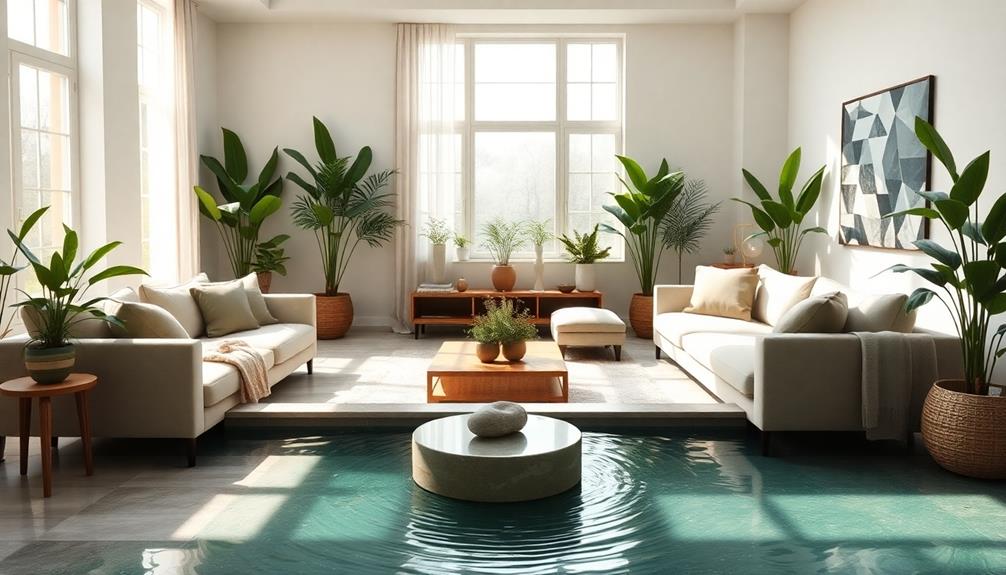
To create a balanced and stylish home, prioritize decluttering. A clutter-free space enhances the flow of positive energy, or Qi, allowing for tranquility and mental clarity. Start by tackling the entryway; remove anything that blocks movement and creates chaos. Keep only what serves a purpose or brings you joy. Regularly reassess your belongings and apply the "one in, one out" rule to maintain an organized environment. Not only will clutter-free areas improve your home's energy, but they'll also create a more inviting atmosphere. Discover additional tips on enhancing your space for ultimate harmony and style.
Key Takeaways
- Position furniture in the "Commanding Position" to enhance mental clarity and control in your space.
- Declutter regularly to promote positive energy flow and reduce stress in your home.
- Use warm, inviting lighting to create a welcoming atmosphere that enhances comfort.
- Incorporate the five elements of Feng Shui through colors and materials in your decor.
- Maintain a clean, organized entryway to welcome positive energy and opportunities into your home.
Understanding Feng Shui Basics
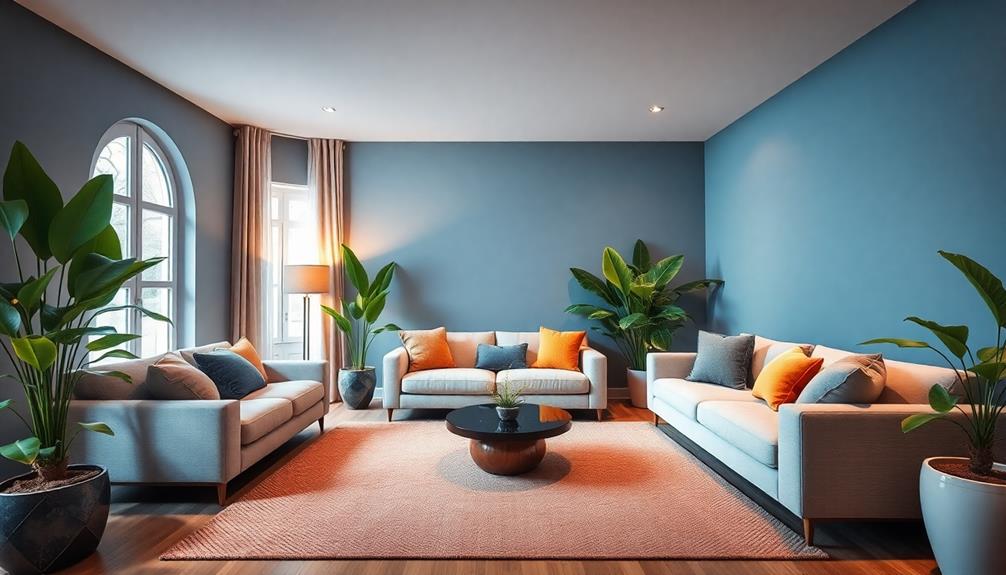
To create a harmonious living environment, it's essential to grasp the basics of Feng Shui. This ancient practice, which translates to "wind" and "water," emphasizes the flow of energy, or Qi, in your space. By understanding Feng Shui rules, you can positively influence the energy around you and enhance your overall well-being.
Integrating elements of Balinese Interior Design can further enhance this balance, as it emphasizes natural materials and a connection to nature, promoting a calming atmosphere.
One key principle is the "Commanding Position." When you position essential furniture, like your bed or desk, so you can see the door, it creates a sense of security and control in your life. This simple adjustment can greatly improve your mental clarity and focus.
Feng Shui also revolves around the balance of the five elements: Fire, Earth, Water, Wood, and Metal. Each element impacts energy differently, and knowing how to incorporate them can transform your space.
Additionally, utilizing the Bagua Map can help you analyze your home. It allows you to identify areas that relate to different life aspects, like health and relationships, guiding you toward effective spatial arrangements.
The Importance of Decluttering

Decluttering is key to enhancing the flow of energy in your home.
By creating clear spaces, you invite positive Qi to circulate freely, reducing stress and promoting peace.
Incorporating eco-friendly practices can also help create a harmonious environment while minimizing waste.
Start with your entryway—it sets the tone for the energy that enters your space.
Enhancing Energy Flow
A clutter-free space is essential for enhancing the flow of chi, or energy, in your home. When pathways are blocked by unnecessary items, stagnation occurs, leading to negative energy accumulation.
By decluttering regularly, you can promote good energy, allowing for a more peaceful and harmonious living environment. Additionally, incorporating unique decor pieces, such as Indonesian masks, can add cultural significance and artistry to your space, enriching its overall vibe and energy flow.
These masks not only serve as striking focal points but also tell stories of rich traditions and craftsmanship from their origin the importance of Indonesian decor masks.
Every piece of furniture and decor should serve a specific purpose. Non-functional items can disrupt balance, so it's crucial to assess what you truly need.
Additionally, cleaning your windows not only invites more natural light but also symbolizes clarity and openness, further facilitating positive energy flow.
Implementing effective storage solutions and organizing your spaces can create a welcoming atmosphere. This inviting environment encourages abundance and positive opportunities to flow into your life.
Creating Clear Spaces
Creating clear spaces in your home is essential for fostering a serene environment. Decluttering allows chi, or energy, to flow freely, reducing feelings of chaos and promoting tranquility. When you keep areas tidy, you prevent energy blockages that lead to stagnation and negativity, enhancing your overall well-being and mental clarity.
Incorporating elements like Indonesian decorative pillows can also add vibrant colors and comfort to your space, making it feel more inviting.
Take time to regularly remove non-functional or unused items. This not only frees up physical space but creates a more inviting and harmonious living environment. A clean and organized entryway is particularly important, as it acts as the first impression of your home, welcoming positive energy and opportunities into your space.
Studies show that individuals who maintain decluttered environments report reduced stress levels and improved focus. By prioritizing decluttering, you're not just cleaning your home; you're also clearing your mind.
Every item you remove contributes to a more balanced atmosphere, allowing you to feel more at ease in your surroundings. Embrace the practice of decluttering, and you'll find that your home becomes a sanctuary filled with positive energy, where you can thrive and enjoy life to the fullest.
Benefits of a Balanced Home
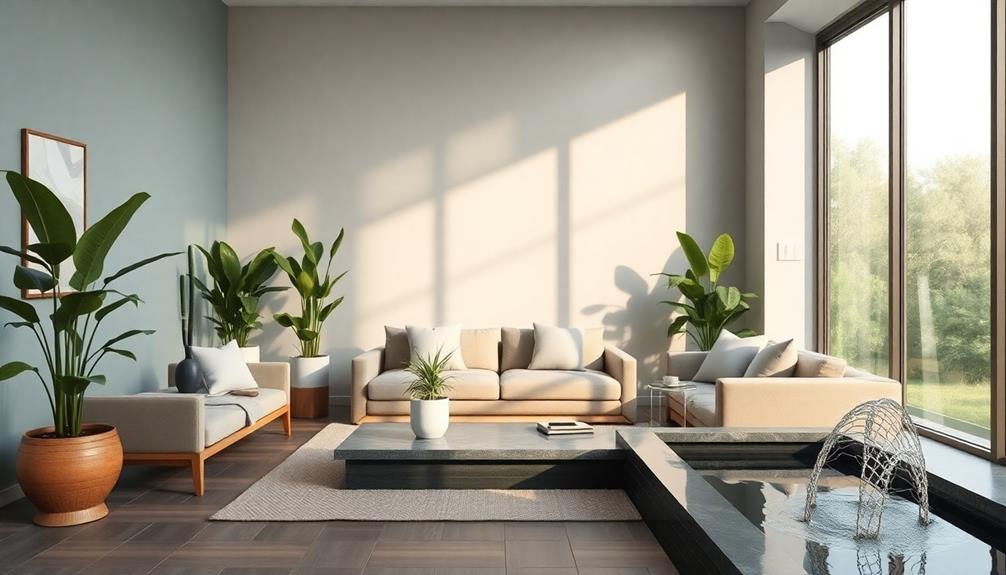
When you achieve a balanced home, you open the door to a wealth of benefits that can transform your daily life. A balanced home enhances the flow of positive energy (Qi), leading to improved mental clarity and emotional well-being. By incorporating the principles of feng shui, you create an environment that reduces stress and anxiety, making your space inviting and harmonious. This aligns well with the growing trend toward eclectic home style that resonates with individuality and personal stories.
Moreover, a well-balanced environment fosters better relationships among household members. When your home feels comfortable and connected, it encourages open communication and strengthens bonds. Organizing and decluttering your living areas not only enhances aesthetics but also greatly improves air quality and overall health, reducing allergens and toxins.
Additionally, a balanced home design boosts your productivity and creativity. Whether you're working from home or pursuing personal projects, a harmonious space provides the ideal backdrop for growth and inspiration.
With these benefits, achieving balance through feng shui isn't just about aesthetics; it's about cultivating a nurturing environment that enriches your life and well-being. Embrace the journey towards a balanced home, and you'll soon experience the transformative effects it can bring to your everyday existence.
Key Feng Shui Principles
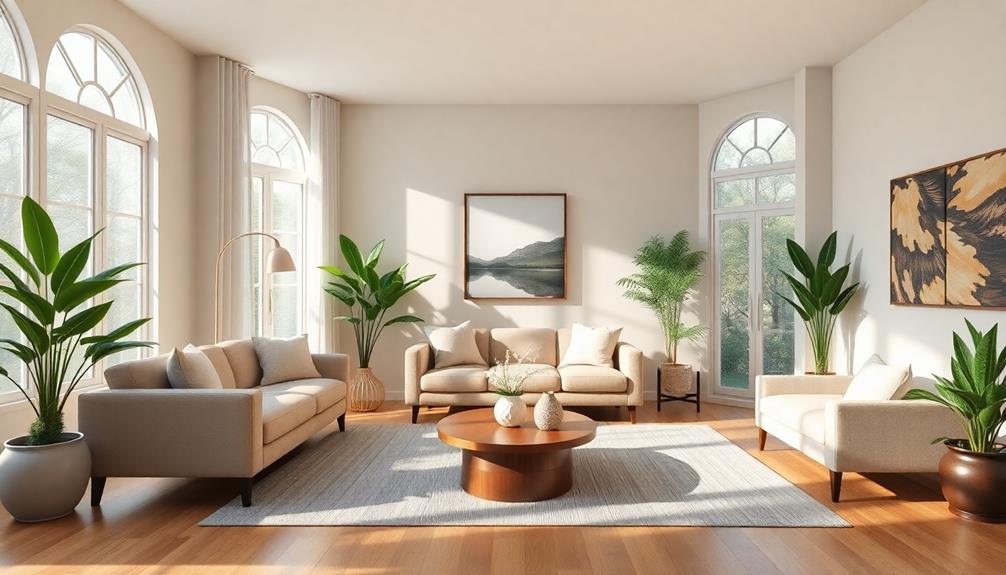
Understanding the key feng shui principles can greatly enhance the energy flow in your home. Start with the Five Elements of Feng Shui: Fire, Earth, Water, Metal, and Wood. Each element carries unique properties that influence the energy within your space. Incorporating these elements effectively promotes balance and harmony, much like how traditional Indonesian style home decor utilizes natural materials to create a serene atmosphere.
Next, consider the Commanding Position. This principle suggests placing essential furniture, like your bed or desk, where you can see the entrance. This arrangement fosters feelings of safety and control, vital for a calming environment.
Achieving a harmonious balance of Yin and Yang is also significant. Yin represents passive energy, while Yang embodies active energy. A well-balanced room will feel peaceful yet vibrant, enhancing your overall well-being.
Utilizing the Bagua Map can help you identify areas of focus in your home. This tool allows you to enhance specific aspects of your life, such as relationships and wealth, through intentional design choices.
Decluttering Strategies for Every Room
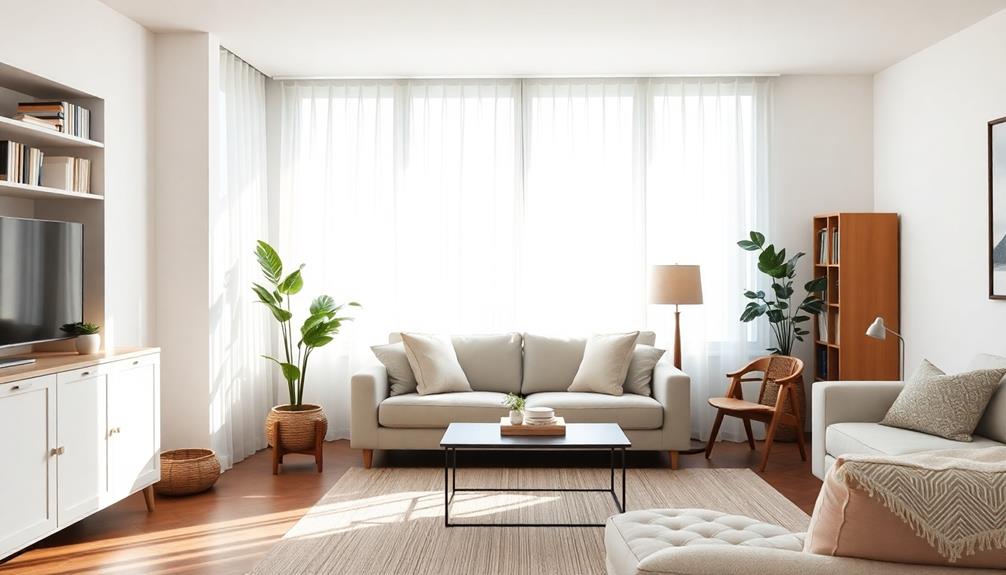
To create a balanced home, you need effective decluttering strategies for each room.
Start with a room-by-room guide, gather essential tools, and learn maintenance tips that keep your space clear and inviting.
Room-by-Room Decluttering Guide
Decluttering your home room by room can transform your space and enhance its energy flow. Start with the entryway; remove shoes, coats, and any items that block movement. A tidy entry creates a welcoming atmosphere, inviting positive energy into your home.
Incorporating elements of Traditional vs. Classic Design can further amplify the aesthetic appeal of your entryway, setting a harmonious tone for the rest of your home.
Next, tackle the living room. Focus on decluttering surfaces like coffee tables and shelves. Verify your furniture arrangement promotes conversation and clear pathways for easy movement, which is essential for good Feng Shui.
In the bedroom, clear out under the bed and declutter your nightstands. Keep only items that promote relaxation and tranquility to enhance restful energy.
Move on to the kitchen by eliminating expired food and organizing pantry items. A clear countertop not only creates a functional cooking environment but also supports positive energy flow while you prepare meals.
Finally, in the bathroom, regularly dispose of unused products and maintain clean surfaces to prevent energy drain.
Don't forget to keep the toilet lid down when not in use, as this helps contain energy and supports a harmonious space.
Essential Decluttering Tools
When it comes to keeping your home clutter-free, having the right tools at your disposal makes all the difference. Start by investing in storage bins and baskets to help you organize items by category. This will make it easier to maintain a clutter-free environment in every room.
Consider incorporating unique decorative elements like an Indonesian decor mask to enhance your space while promoting cultural appreciation. A labeling system for your boxes and containers can enhance organization, allowing you to quickly identify contents without rummaging through clutter.
Implementing the "one in, one out" rule is another effective strategy. For every new item you bring into your home, remove an old one. This simple practice helps you manage your belongings and prevents accumulation.
Schedule regular decluttering sessions, ideally every season, to assess what no longer serves a purpose or brings joy. Focus on high-traffic areas like entryways and living rooms first, as these spaces considerably impact the overall energy flow in your home.
Maintenance Tips for Clarity
Creating a balanced home goes beyond just decluttering; it involves maintaining clarity in every room. Start your journey at the entryway—this is where positive energy flows into your home. To keep that energy vibrant, implement the "one in, one out" rule: for every new item, remove one old item. Focus your efforts by tackling one room at a time with a designated decluttering schedule, so you don't feel overwhelmed.
Utilize storage solutions like baskets and bins to keep items organized, making it easier to maintain a tidy environment and enhance energy flow. Regularly assess your belongings for both functionality and emotional connection. If something no longer serves a purpose or brings joy, consider letting it go to prevent energy stagnation.
Here are some quick Shui Tips for maintaining clarity:
| Area | Strategy | Frequency |
|---|---|---|
| Entryway | Clear shoes and coats | Daily |
| Living Room | Organize books and decor | Weekly |
| Bedroom | Sort clothes and personal items | Monthly |
Enhancing Energy Flow
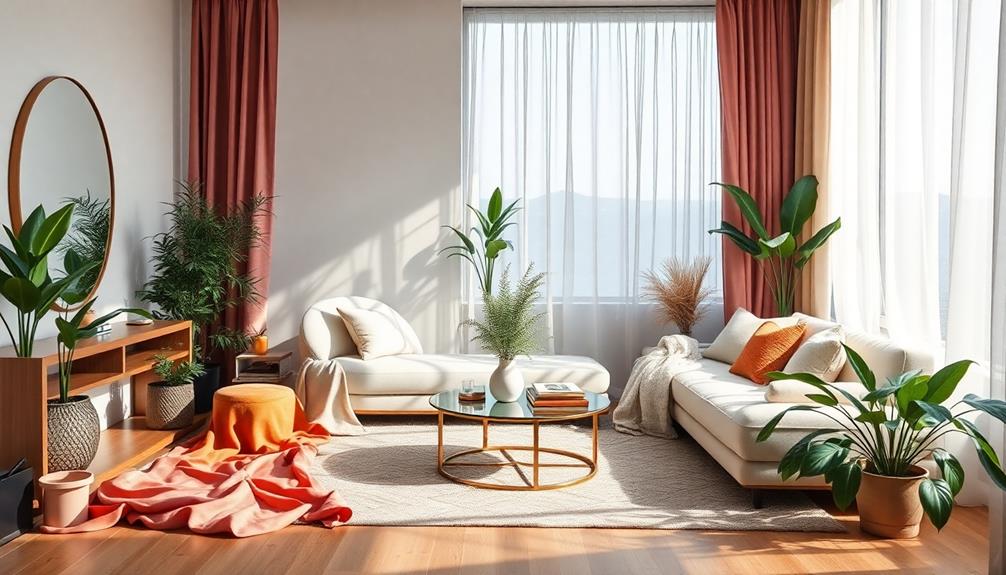
A clutter-free environment is essential for enhancing energy flow in your home. Clutter disrupts chi and creates blockages that hinder positive energy movement, so start by decluttering each space.
Once you've cleared the clutter, focus on maintaining clear pathways throughout your home. This allows energy to flow freely and guarantees you can navigate your space without physical obstacles.
Incorporating elements from Bohemian decor styles can also invigorate your spaces with life energy, as they often include natural materials and vibrant textiles that promote harmony.
Additionally, consider using mirrors strategically. They can reflect positive energy and light into a room, but make sure they don't face the front door or reflect negative elements like a toilet.
Lastly, pay attention to your entryway, as it symbolizes how energy enters your home. Keep it clean and welcoming, adding warm lighting and plants to create a vibrant atmosphere.
Creating a Welcoming Entryway
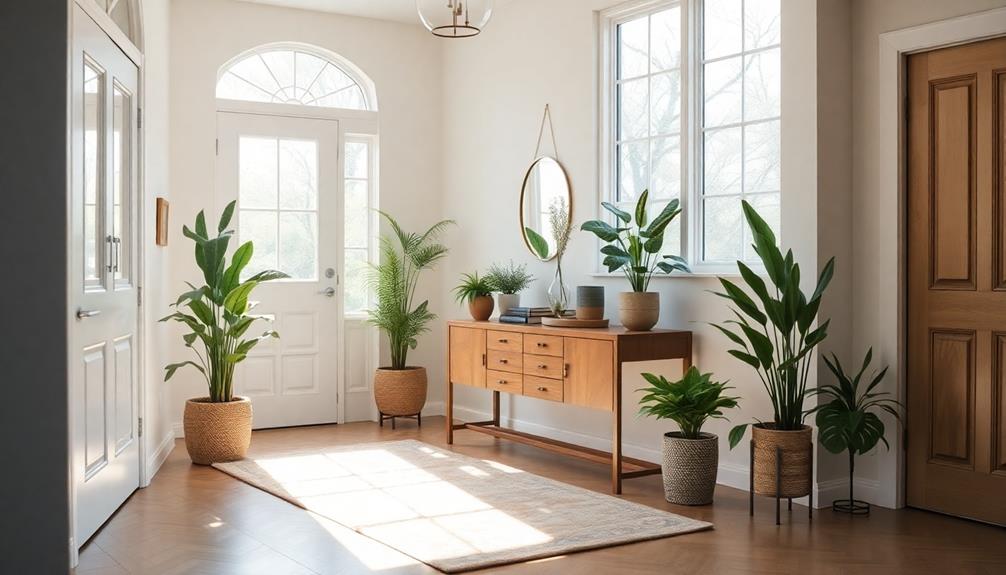
To create a welcoming entryway, start by clearing clutter to let positive energy flow into your home.
Next, choose inviting lighting that sets a warm tone for guests as they arrive.
Clear Clutter Effectively
Clear clutter in your entryway to invite positive energy into your home. A tidy entryway promotes the smooth flow of Qi, creating a welcoming atmosphere that enhances good vibes.
Start by evaluating what you really need in this space. In traditional Indonesian housing, for example, the entryway often serves as a communal area reflecting the household's cultural significance and identity traditional homes as community spaces. Use storage solutions like baskets or cabinets to organize shoes, coats, and other items, keeping everything neat and functional.
Regularly cleaning your entryway is essential. Dust, sweep, and clear away any unnecessary items to maintain clarity and guarantee energy can gather freely.
Adding a touch of greenery, such as a peace lily or jade plant, can infuse liveliness and fresh energy into your home. These plants not only look great but also help purify the air, contributing to overall positivity.
Take a moment to reflect on your lighting as well. While we won't explore it just yet, know that soft, warm lighting can further enhance the inviting ambiance of your entryway.
Inviting Lighting Choices
Creating a harmonious entryway goes beyond just clearing clutter; inviting lighting choices play a significant role in establishing a warm atmosphere. To welcome positive energy into your home, implement warm, soft lighting that instantly makes the space feel more inviting. Statement light fixtures, like chandeliers or pendant lights, can't only enhance the aesthetic appeal but also draw attention to your entryway.
Make sure your entryway is well-lit to promote safety and visibility. A well-illuminated space dispels darkness, which can create unease and hinder energy flow. Consider incorporating dimmable lights, allowing you to adjust brightness according to the time of day or mood, adding versatility to the area.
Avoid harsh, fluorescent lighting that can create a cold environment. Instead, opt for layered lighting that combines ambient, task, and accent lighting. This combination provides depth and enhances the inviting atmosphere you're aiming for.
Strategic Mirror Placement
Strategically placing mirrors can often enhance your entryway, making it feel more spacious and inviting. Position mirrors on the side walls instead of directly opposite the door. This approach allows for a better energy flow (Qi) as you enter, helping to maintain balance and harmony in your home.
Use mirrors to reflect positive elements, such as plants or natural light, which can amplify liveliness and create a welcoming atmosphere. However, be cautious about what your mirrors reflect; avoid placing them where they can show the toilet or other negative spaces, as this can lead to unwanted energy and disrupt the overall vibe.
Make sure your mirror placement is proportional to the space. Oversized mirrors can overwhelm a small entryway, while smaller ones mightn't serve the purpose effectively.
Regularly cleaning your mirrors is also essential; clear reflections symbolize clarity and positivity, which promotes a fresh and inviting entryway.
Feng Shui for Living Spaces
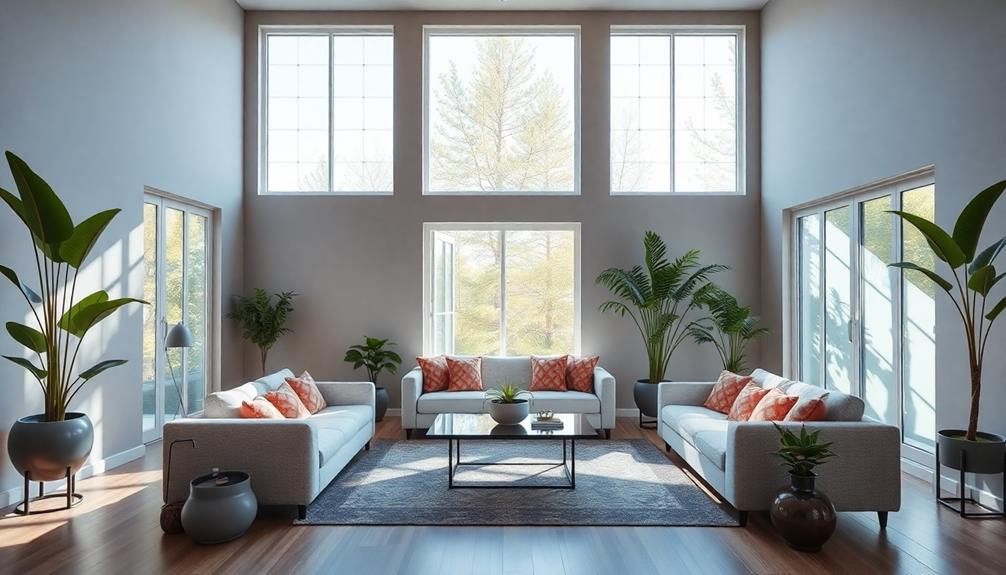
Your living space plays an essential role in how energy flows and affects your daily life. To harness positive energy with Feng Shui in your home, start by arranging your furniture in a way that promotes conversation and energy flow. Use the Commanding Position, where seating faces the entrance, allowing you to see who enters.
Incorporate the five elements—Wood, Fire, Earth, Metal, and Water—through your color choices, materials, and shapes. For instance, use warm colors to foster a welcoming atmosphere and cool tones for calmness.
Natural light is important too; let it flood your space to energize the environment.
Bring in liveliness and fresh energy by introducing plants like jade or peace lilies. They enhance both aesthetics and air quality, contributing to a healthier living space.
Additionally, keep pathways clear and declutter regularly to facilitate smooth energy flow, allowing chi to circulate freely.
Designing a Peaceful Bedroom
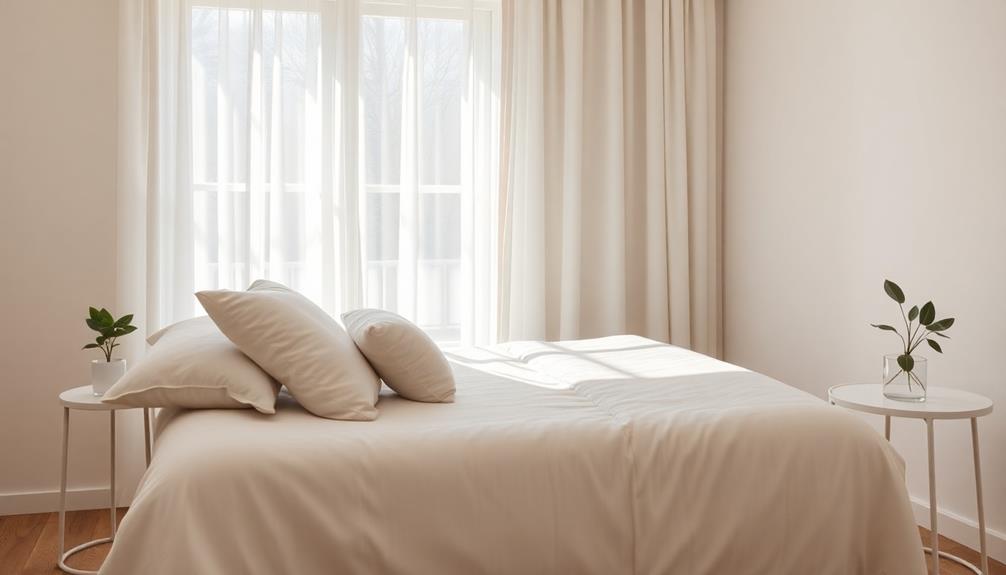
A peaceful bedroom is essential for restorative sleep and overall well-being. To create this serene space, start by positioning your bed in the Commanding Position. This means placing it where you have a clear view of the door without being directly aligned with it, which promotes a sense of security while you rest.
Next, keep your bedroom free of clutter, especially under the bed. This helps energy flow smoothly, fostering a tranquil environment conducive to relaxation.
Opt for warm, soft lighting like bedside lamps with dimmers to cultivate a soothing atmosphere perfect for winding down.
When it comes to textiles and decor, choose natural materials such as cotton, linen, and bamboo. These elements enhance the calming energy within your bedroom.
Additionally, select a tranquil color palette featuring neutral and soothing shades. This can greatly reduce stress and foster a peaceful retreat.
Harmonizing Your Kitchen Space
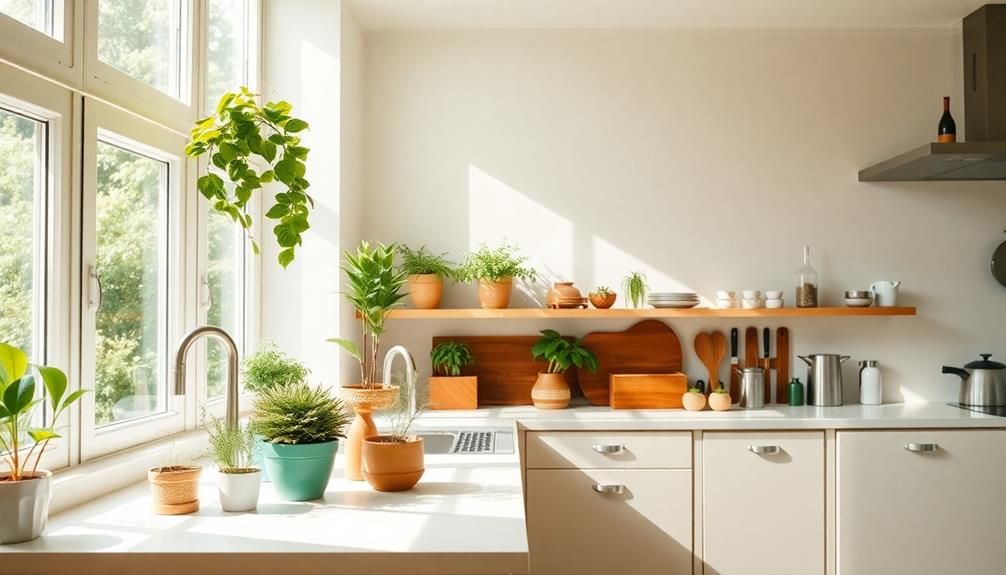
Creating a harmonious kitchen space can transform your cooking and dining experience. Start by ensuring that your stove and sink aren't positioned directly opposite each other, as this can create conflicting energies. Instead, use wooden elements to bridge the gap and balance these opposing forces.
Incorporate vibrant colors like red, orange, or yellow in your kitchen accessories to stimulate appetite and encourage lively conversations. Keep your space clean and organized to prevent any blockage of positive energy.
Implement the classic kitchen triangle layout, positioning the stove, sink, and refrigerator in a triangular formation. This promotes efficient workflow and enhances the overall energy flow within your kitchen.
Utilize natural materials such as wood, stone, and ceramic to enhance the earth element. This will promote warmth and stability in this essential space.
Finally, regularly declutter your countertops and cabinets to facilitate smooth energy flow, and maintain a welcoming atmosphere. Remember, clutter disrupts the chi and creates chaos in your kitchen.
Frequently Asked Questions
How to Organize Your Home According to Feng Shui?
To organize your home according to feng shui, start by decluttering, use the Bagua map for specific areas, position key furniture in the Commanding Position, and incorporate the five elements for balance and harmony.
How to Make a House Lucky in Feng Shui?
To make your house lucky in Feng Shui, position key furniture wisely, incorporate the five elements throughout, keep your entryway clear, and add plants for liveliness. These practices enhance positive energy and promote overall well-being.
How to Design a House According to Feng Shui?
"Home is where the heart is." To design your house with feng shui, position key furniture for energy flow, declutter spaces, use calming colors, and incorporate natural elements for harmony and balance throughout your home.
What Are the Feng Shui Rules for a House?
To create harmony in your home, place key furniture in the Commanding Position, use the Bagua Map for life areas, incorporate the Five Elements, keep entryways clear, and maintain cleanliness for ideal energy flow.
Conclusion
You might think that achieving a balanced and stylish home through feng shui is complicated, but it's actually simpler than you think. By focusing on decluttering and applying key principles, you can transform your space into a harmonious sanctuary. Imagine walking into a clutter-free entryway that instantly lifts your spirits or lounging in a peaceful bedroom that invites relaxation. With just a few mindful adjustments, your home can reflect both balance and style, making every day feel more inviting.
-

 Breaking News3 months ago
Breaking News3 months agoFinancial Meltdown: The Collapse of Major Corporations Explained
-

 Breaking News3 months ago
Breaking News3 months agoClimate Change Reality: New Data Shows Urgent Need for Action
-

 Business3 months ago
Business3 months agoThought Leadership: Navigating the Complexities of Climate Policy
-

 Lifestyle3 months ago
Lifestyle3 months agoHoroscope August 2024 Insights & Astro Predictions
-

 Business3 months ago
Business3 months agoAnalysis: How Social Media is Reshaping Political Campaigns
-

 Breaking News3 months ago
Breaking News3 months agoEnvironmental Catastrophe: The Truth Behind the Recent Disaster
-

 Breaking News3 months ago
Breaking News3 months agoCrime Wave: Inside the Surge of Urban Violence
-

 Breaking News3 months ago
Breaking News3 months agoEducation Crisis: The Impact of School Closures on Students





